Chapter 1 Basic Radiation Physics Slide set of

Chapter 1: Basic Radiation Physics Slide set of 194 slides based on the chapter authored by E. B. Podgorsak of the IAEA publication (ISBN 92 -0 -107304 -6): Review of Radiation Oncology Physics: A Handbook for Teachers and Students Objective: To familiarize the student with the basic principles of radiation physics and modern physics used in radiotherapy. Slide set prepared in 2006 by E. B. Podgorsak (Montreal, Mc. Gill University) Comments to S. Vatnitsky: dosimetry@iaea. org IAEA International Atomic Energy Agency

CHAPTER 1. 1. 1. 2. 1. 3. 1. 4. TABLE OF CONTENTS Introduction Atomic and nuclear structure Electron interactions Photon interactions IAEA Review of Radiation Oncology Physics: A Handbook for Teachers and Students - 1.

1. 1 INTRODUCTION 1. 1. 1 Fundamental physical constants q q q q Avogadro’s number: Speed of light in vacuum: Electron charge: Electron rest mass: Proton rest mass: Neutron rest mass: Atomic mass unit: IAEA Review of Radiation Oncology Physics: A Handbook for Teachers and Students - 1. 1. 1 Slide 1

1. 1 INTRODUCTION 1. 1. 2 Derived physical constants q Reduced Planck’s constant speed of light in vacuum q Fine structure constant q Classical electron radius IAEA Review of Radiation Oncology Physics: A Handbook for Teachers and Students - 1. 1. 2 Slide 1

1. 1 INTRODUCTION 1. 1. 2 Derived physical constants q Bohr radius: q Rydberg energy: q Rydberg constant: IAEA Review of Radiation Oncology Physics: A Handbook for Teachers and Students - 1. 1. 2 Slide 2

1. 1 INTRODUCTION 1. 1. 3 Physical quantities and units q Physical quantities are characterized by their numerical value (magnitude) and associated unit. q Symbols for physical quantities are set in italic type, while symbols for units are set in roman type. For example: IAEA Review of Radiation Oncology Physics: A Handbook for Teachers and Students - 1. 1. 3 Slide 1

1. 1 INTRODUCTION 1. 1. 3 Physical quantities and units q The numerical value and the unit of a physical quantity must be separated by space. For example: q The currently used metric system of units is known as the Systéme International d’Unités (International system of units) or the SI system. IAEA Review of Radiation Oncology Physics: A Handbook for Teachers and Students - 1. 1. 3 Slide 2

1. 1 INTRODUCTION 1. 1. 3 Physical quantities and units The SI system of units is founded on base units for seven physical quantities: Quantity SI unit length mass m time t electric current (I) temperature (T) amount of substance luminous intensity IAEA meter (m) kilogram (kg) second (s) ampère (A) kelvin (K) mole (mol) candela (cd) Review of Radiation Oncology Physics: A Handbook for Teachers and Students - 1. 1. 3 Slide 3

1. 1 INTRODUCTION 1. 1. 4 Classification of forces in nature There are four distinct forces observed in interaction between various types of particles Force Source Transmitted particle Relative strength Strong charge Gluon 1 EM Electric charge Photon 1/137 Weak charge W+, W-, and Zo Gravitational Energy Graviton IAEA Review of Radiation Oncology Physics: A Handbook for Teachers and Students - 1. 1. 4 Slide 1

1. 1 INTRODUCTION 1. 1. 5 Classification of fundamental particles Two classes of fundamental particles are known: q Quarks are particles that exhibit strong interactions Quarks are constituents of hadrons with a fractional electric charge (2/3 or -1/3) and are characterized by one of three types of strong charge called color (red, blue, green). q Leptons are particles that do not interact strongly. Electron, muon, tau, and their corresponding neutrinos IAEA Review of Radiation Oncology Physics: A Handbook for Teachers and Students - 1. 1. 5 Slide 1

1. 1 INTRODUCTION 1. 1. 6 Classification of radiation Radiation is classified into two main categories: q Non-ionizing radiation (cannot ionize matter). q Ionizing radiation (can ionize matter). • Directly ionizing radiation (charged particles) electron, proton, alpha particle, heavy ion • Indirectly ionizing radiation (neutral particles) photon (x ray, gamma ray), neutron IAEA Review of Radiation Oncology Physics: A Handbook for Teachers and Students - 1. 1. 6 Slide 1

1. 1 INTRODUCTION 1. 1. 6 Classification of radiation Radiation is classified into two main categories: IAEA Review of Radiation Oncology Physics: A Handbook for Teachers and Students - 1. 1. 6 Slide 2

1. 1 INTRODUCTION 1. 1. 7 Classification of ionizing photon radiation Ionizing photon radiation is classified into four categories: q Characteristic x ray Results from electronic transitions between atomic shells. q Bremsstrahlung Results mainly from electron-nucleus Coulomb interactions. q Gamma ray Results from nuclear transitions. q Annihilation quantum (annihilation radiation) Results from positron-electron annihilation. IAEA Review of Radiation Oncology Physics: A Handbook for Teachers and Students - 1. 1. 7 Slide 1

1. 1 INTRODUCTION 1. 1. 8 Einstein’s relativistic mass, energy, and momentum q Mass: q Normalized mass: where IAEA and Review of Radiation Oncology Physics: A Handbook for Teachers and Students - 1. 1. 8 Slide 1

1. 1 INTRODUCTION 1. 1. 8 Einstein’s relativistic mass, energy, and momentum IAEA Review of Radiation Oncology Physics: A Handbook for Teachers and Students - 1. 1. 8 Slide 2

1. 1 INTRODUCTION 1. 1. 8 Einstein’s relativistic mass, energy, and momentum q Total energy: q Rest energy: q Kinetic energy: q Momentum: with IAEA and Review of Radiation Oncology Physics: A Handbook for Teachers and Students - 1. 1. 8 Slide 3

1. 1 INTRODUCTION 1. 1. 9 Radiation quantities and units IAEA Review of Radiation Oncology Physics: A Handbook for Teachers and Students - 1. 1. 9 Slide 1

1. 2 ATOMIC AND NUCLEAR STRUCTURE 1. 2. 1 Basic definitions for atomic structure q The constituent particles forming an atom are: • Proton • Neutron • Electron Protons and neutrons are known as nucleons and form the nucleus. q Atomic number Z Number of protons and number of electrons in an atom. IAEA Review of Radiation Oncology Physics: A Handbook for Teachers and Students - 1. 2. 1 Slide 1

1. 2 ATOMIC AND NUCLEAR STRUCTURE 1. 2. 1 Basic definitions for atomic structure q Atomic mass number A Number of nucleons (Z+N) in an atom, where • Z is the number of protons (atomic number) in an atom • N is the number of neutrons in an atom. IAEA Review of Radiation Oncology Physics: A Handbook for Teachers and Students - 1. 2. 1 Slide 2

1. 2 ATOMIC AND NUCLEAR STRUCTURE 1. 2. 1 Basic definitions for atomic structure q There is no basic relation between the atomic mass number A and atomic number Z of a nucleus but the empirical relationship: furnishes a good approximation for stable nuclei. IAEA Review of Radiation Oncology Physics: A Handbook for Teachers and Students - 1. 2. 1 Slide 3

1. 2 ATOMIC AND NUCLEAR STRUCTURE 1. 2. 1 Basic definitions for atomic structure q Atomic gram-atom is defined as the number of grams of an atomic compound that contains exactly one Avogadro’s number of atoms, i. e. , q Atomic mass numbers A of all elements are defined so that A grams of every element contain exactly NA atoms. q For example: • 1 gram-atom of cobalt-60 is 60 g of cobalt-60. • 1 gram-atom of radium-226 is 226 g of radium-226. IAEA Review of Radiation Oncology Physics: A Handbook for Teachers and Students - 1. 2. 1 Slide 4

1. 2 ATOMIC AND NUCLEAR STRUCTURE 1. 2. 1 Basic definitions for atomic structure q Molecular gram-mole is defined as the number of grams of a molecular compound that contains exactly one Avogadro’s number of molecules, i. e. , q The mass of a molecule is the sum of the masses of the atoms that make up the molecule. q For example: • 1 mole of water is 18 g of water. • 1 mole of carbon dioxide is 44 g of carbon dioxide. IAEA Review of Radiation Oncology Physics: A Handbook for Teachers and Students - 1. 2. 1 Slide 5

1. 2 ATOMIC AND NUCLEAR STRUCTURE 1. 2. 1 Basic definition for atomic structure q The atomic mass M is expressed in atomic mass units u • 1 u is equal to 1/12 th of the mass of the carbon-12 atom or 931. 5 Me. V/c 2. • The atomic mass M is smaller than the sum of the individual masses of constituent particles because of the intrinsic energy associated with binding the particles (nucleons) within the nucleus. IAEA Review of Radiation Oncology Physics: A Handbook for Teachers and Students - 1. 2. 1 Slide 6

1. 2 ATOMIC AND NUCLEAR STRUCTURE 1. 2. 1 Basic definition for atomic structure q The nuclear mass M is defined as the atomic mass with the mass of atomic orbital electrons subtracted, i. e. , The binding energy of orbital electrons to the nucleus is neglected. IAEA Review of Radiation Oncology Physics: A Handbook for Teachers and Students - 1. 2. 1 Slide 7

1. 2 ATOMIC AND NUCLEAR STRUCTURE 1. 2. 1 Basic definitions for atomic structure In nuclear physics the convention is to designate a nucleus X as , where A is the atomic mass number Z is the atomic number For example: • • Cobalt-60 nucleus with Z = 27 protons and A = 33 neutrons is identified as. Radium-226 nucleus with 88 protons and 138 neutrons is identified as. IAEA Review of Radiation Oncology Physics: A Handbook for Teachers and Students - 1. 2. 1 Slide 8

1. 2 ATOMIC AND NUCLEAR STRUCTURE 1. 2. 1 Basic definitions for atomic structure q Number of atoms Na per mass m of an element: q Number of electrons Ne per volume V of an element: IAEA Review of Radiation Oncology Physics: A Handbook for Teachers and Students - 1. 2. 1 Slide 9

1. 2 ATOMIC AND NUCLEAR STRUCTURE 1. 2. 1 Basic definitions for atomic structure q For all elements with two notable exceptions: • Hydrogen-1 for which • Helium-3 for which q Actually, . gradually decreases: • from 0. 5 for low atomic number Z elements • to ~0. 4 for high atomic number Z elements. q For example: IAEA Review of Radiation Oncology Physics: A Handbook for Teachers and Students - 1. 2. 1 Slide 10

1. 2 ATOMIC AND NUCLEAR STRUCTURE 1. 2. 2 Rutherford’s model of the atom q Rutherford’s atomic model is based on results of the Geiger-Marsden experiment of 1909 with 5. 5 Me. V alpha particles scattered on thin gold foils with a thickness of the order of 10 -6 m. IAEA Review of Radiation Oncology Physics: A Handbook for Teachers and Students - 1. 2. 2 Slide 1

1. 2 ATOMIC AND NUCLEAR STRUCTURE 1. 2. 2 Rutherford’s model of the atom q At the time of the Geiger-Marsden experiment Thomson atomic model was the prevailing atomic model. q The model was based on an assumption that the positive and the negative (electron) charges of the atom were distributed uniformly over the atomic volume (“plum-pudding model”). IAEA Review of Radiation Oncology Physics: A Handbook for Teachers and Students - 1. 2. 2 Slide 2

1. 2 ATOMIC AND NUCLEAR STRUCTURE 1. 2. 2 Rutherford’s model of the atom q Geiger and Marsden found that more than 99 % of the alpha particles incident on the gold foil were scattered at scattering angles less than 3 o and that the distribution of scattered alpha particles followed a Gaussian shape. q Geiger and Marsden also found that roughly one in 104 alpha particles was scattered with a scattering angle exceeding 90 o (probability 10 -4) q This finding was in drastic disagreement with theoretical prediction of one in 103500 resulting from the Thomson’s atomic model (probability 10 -3500). IAEA Review of Radiation Oncology Physics: A Handbook for Teachers and Students - 1. 2. 2 Slide 3

1. 2 ATOMIC AND NUCLEAR STRUCTURE 1. 2. 2 Rutherford’s model of the atom q Ernest Rutherford concluded that the peculiar results of the Geiger-Marsden experiment did not support the Thomson’s atomic model and proposed the currently accepted atomic model in which: • Mass and positive charge of the atom are concentrated in the nucleus the size of which is of the order of 10 -15 m. • Negatively charged electrons revolve about the nucleus in a spherical cloud on the periphery of the Rutherford atom with a radius of the order of 10 -10 m. IAEA Review of Radiation Oncology Physics: A Handbook for Teachers and Students - 1. 2. 2 Slide 4

1. 2 ATOMIC AND NUCLEAR STRUCTURE 1. 2. 2 Rutherford’s model of the atom q Based on his model and four additional assumptions, Rutherford derived the kinematics for the scattering of alpha particles on gold nuclei using basic principles of classical mechanics. q The four assumptions are related to: • • Mass of the gold nucleus. Scattering of alpha particles. Penetration of the nucleus. Kinetic energy of the alpha particles. IAEA Review of Radiation Oncology Physics: A Handbook for Teachers and Students - 1. 2. 2 Slide 5

1. 2 ATOMIC AND NUCLEAR STRUCTURE 1. 2. 2 Rutherford’s model of the atom q The four assumptions are: • Mass of the gold nucleus >> mass of the alpha particle. • Scattering of alpha particles on atomic electrons is negligible. • Alpha particle does not penetrate the nucleus, i. e. , there are no nuclear reactions occurring. • Alpha particles with kinetic energies of the order of a few Me. V are non-relativistic and the simple classical relationship for the kinetic energy EK of the alpha particle is valid: IAEA Review of Radiation Oncology Physics: A Handbook for Teachers and Students - 1. 2. 2 Slide 6

1. 2 ATOMIC AND NUCLEAR STRUCTURE 1. 2. 2 Rutherford’s model of the atom As a result of the repulsive Coulomb interaction between the alpha particle (charge +2 e) and the nucleus (charge +Ze) the alpha particle follows a hyperbolic trajectory. IAEA Review of Radiation Oncology Physics: A Handbook for Teachers and Students - 1. 2. 2 Slide 7

1. 2 ATOMIC AND NUCLEAR STRUCTURE 1. 2. 2 Rutherford’s model of the atom q The shape of the hyperbolic trajectory and the scattering angle depend on the impact parameter b. The limiting case is a direct hit with and (backscattering) that, assuming conservation of energy, determines the distance of closest approach in a direct hit (backscattering) interaction. IAEA Review of Radiation Oncology Physics: A Handbook for Teachers and Students - 1. 2. 2 Slide 8

1. 2 ATOMIC AND NUCLEAR STRUCTURE 1. 2. 2 Rutherford’s model of the atom q The shape of the hyperbolic trajectory and the scattering angle are a function of the impact parameter b. q The repulsive Coulomb force between the alpha particle (charge ze, z = 2) and the nucleus (charge Ze) is governed by dependence: where r is the separation between the two charged particles. IAEA Review of Radiation Oncology Physics: A Handbook for Teachers and Students - 1. 2. 2 Slide 9

1. 2 ATOMIC AND NUCLEAR STRUCTURE 1. 2. 2 Rutherford’s model of the atom q The relationship between the impact parameter b and the scattering angle follows from the conservation of energy and momentum considerations: q This expression is derived using: • The classical relationship for the kinetic energy of the particle: • The definition of in a direct hit head-on collision for which the impact parameter b = 0 and the scattering angle. IAEA Review of Radiation Oncology Physics: A Handbook for Teachers and Students - 1. 2. 2 Slide 10

1. 2 ATOMIC AND NUCLEAR STRUCTURE 1. 2. 2 Rutherford’s model of the atom The differential Rutherford scattering cross section is: IAEA Review of Radiation Oncology Physics: A Handbook for Teachers and Students - 1. 2. 2 Slide 11

1. 2 ATOMIC AND NUCLEAR STRUCTURE 1. 2. 3 Bohr’s model of the hydrogen atom q Niels Bohr in 1913 combined Rutherford’s concept of the nuclear atom with Planck’s idea of the quantized nature of the radiation process and developed an atomic model that successfully deals with one-electron structures, such as the hydrogen atom, singly ionized helium, etc. • M nucleus with mass M • me electron with mass me • rn radius of electron orbit IAEA Review of Radiation Oncology Physics: A Handbook for Teachers and Students - 1. 2. 3 Slide 1

1. 2 ATOMIC AND NUCLEAR STRUCTURE 1. 2. 3 Bohr’s model of the hydrogen atom q Bohr’s atomic model is based on four postulates: • Postulate 1: Electrons revolve about the Rutherford nucleus in well-defined, allowed orbits (planetary-like motion). • Postulate 2: While in orbit, the electron does not lose any energy despite being constantly accelerated (no energy loss while electron is in allowed orbit). • Postulate 3: The angular momentum of the electron in an allowed orbit is quantized (quantization of angular momentum). • Postulate 4: An atom emits radiation only when an electron makes a transition from one orbit to another (energy emission during orbital transitions). IAEA Review of Radiation Oncology Physics: A Handbook for Teachers and Students - 1. 2. 3 Slide 2

1. 2 ATOMIC AND NUCLEAR STRUCTURE 1. 2. 3 Bohr’s model of the hydrogen atom Bohr’s atomic model is based on four postulates: Postulate 1: Planetary motion of electrons • Electrons revolve about the Rutherford nucleus in welldefined, allowed orbits. • The Coulomb force of attraction between the electron and the positively charged nucleus is balanced by the centrifugal force. IAEA Review of Radiation Oncology Physics: A Handbook for Teachers and Students - 1. 2. 3 Slide 3

1. 2 ATOMIC AND NUCLEAR STRUCTURE 1. 2. 3 Bohr’s model of the hydrogen atom Bohr’s atomic model is based on four postulates: Postulate 2: No energy loss while electron is in orbit. • While in orbit, the electron does not lose any energy despite being constantly accelerated. • This is a direct contravention of the basic law of nature (Larmor’s law) which states that: “Any time a charged particle is accelerated or decelerated part of its energy is emitted in the form of photon (bremsstrahlung)”. IAEA Review of Radiation Oncology Physics: A Handbook for Teachers and Students - 1. 2. 3 Slide 4

1. 2 ATOMIC AND NUCLEAR STRUCTURE 1. 2. 3 Bohr’s model of the hydrogen atom Bohr’s atomic model is based on four postulates: Postulate 3: Quantization of angular momentum • The angular momentum of the electron in an allowed orbit is quantized and given as , where n is an integer referred to as the principal quantum number and. • The lowest possible angular momentum of electron in an allowed orbit is . • All atomic orbital electron angular momenta are integer multiples of IAEA . Review of Radiation Oncology Physics: A Handbook for Teachers and Students - 1. 2. 3 Slide 5

1. 2 ATOMIC AND NUCLEAR STRUCTURE 1. 2. 3 Bohr’s model of the hydrogen atom Bohr’s atomic model is based on four postulates: Postulate 4: Emission of photon during atomic transition. • An atom emits radiation only when an electron makes a transition from an initial allowed orbit with quantum number ni to a final orbit with quantum number nf. • The energy of the emitted photon equals the difference in energy between the two atomic orbits. IAEA Review of Radiation Oncology Physics: A Handbook for Teachers and Students - 1. 2. 3 Slide 6

1. 2 ATOMIC AND NUCLEAR STRUCTURE 1. 2. 3 Bohr’s model of the hydrogen atom q Radius rn of a one-electron Bohr atom is: q Velocity IAEA of the electron in a one-electron Bohr atom is: Review of Radiation Oncology Physics: A Handbook for Teachers and Students - 1. 2. 3 Slide 7

1. 2 ATOMIC AND NUCLEAR STRUCTURE 1. 2. 3 Bohr’s model of the hydrogen atom q Energy levels En of orbital electron shells in a one-electron Bohr atom are: q Wave number k for transition from shell ni to shell nf : IAEA Review of Radiation Oncology Physics: A Handbook for Teachers and Students - 1. 2. 3 Slide 8

1. 2 ATOMIC AND NUCLEAR STRUCTURE 1. 2. 3 Bohr’s model of the hydrogen atom q Energy levels En of orbital electron shells in a one-electron Bohr atom are: q ER = Rydberg energy IAEA Review of Radiation Oncology Physics: A Handbook for Teachers and Students - 1. 2. 3 Slide 9

1. 2 ATOMIC AND NUCLEAR STRUCTURE 1. 2. 3 Bohr’s model of the hydrogen atom The velocity of the orbital electron in the ground state n = 1 is less than 1 % of the speed of light for the hydrogen atom with Z = 1. Therefore, the use of classical mechanics in the derivation of the kinematics of the Bohr atom is justified. IAEA Review of Radiation Oncology Physics: A Handbook for Teachers and Students - 1. 2. 3 Slide 10

1. 2 ATOMIC AND NUCLEAR STRUCTURE 1. 2. 3 Bohr’s model of the hydrogen atom q Both Rutherford and Bohr used classical mechanics in their discoveries of the atomic structure and the kinematics of the electronic motion, respectively. q Rutherford introduced the idea of atomic nucleus that contains most of the atomic mass and is 5 orders of magnitude smaller than the atom. q Bohr introduced the idea of electronic angular momentum quantization. IAEA Review of Radiation Oncology Physics: A Handbook for Teachers and Students - 1. 2. 3 Slide 11

1. 2 ATOMIC AND NUCLEAR STRUCTURE 1. 2. 3 Bohr’s model of the hydrogen atom q Nature provided Rutherford with an atomic probe (naturally occurring alpha particles) having just the appropriate energy (few Me. V) to probe the atom without having to deal with relativistic effects and nuclear penetration. q Nature provided Bohr with the hydrogen one-electron atom in which the electron can be treated with simple classical relationships. IAEA Review of Radiation Oncology Physics: A Handbook for Teachers and Students - 1. 2. 3 Slide 12

1. 2 ATOMIC AND NUCLEAR STRUCTURE 1. 2. 3 Bohr’s model of the hydrogen atom Energy level diagram for the hydrogen atom. n=1 n>1 ground state excited states Wave number of emitted photon IAEA Review of Radiation Oncology Physics: A Handbook for Teachers and Students - 1. 2. 3 Slide 13

1. 2 ATOMIC AND NUCLEAR STRUCTURE 1. 2. 4 Multi-electron atom q Bohr theory works well for one-electron structures but does not apply directly to multi-electron atoms because of the repulsive Coulomb interactions among the atomic electrons. q Electrons occupy allowed shells; however, the number of electrons per shell is limited to 2 n 2. q Energy level diagrams of multi-electron atoms resemble those of one-electron structures, except that inner shell electrons are bound with much larger energies than ER. IAEA Review of Radiation Oncology Physics: A Handbook for Teachers and Students - 1. 2. 4 Slide 1

1. 2 ATOMIC AND NUCLEAR STRUCTURE 1. 2. 4 Multi-electron atoms q Douglas Hartree proposed an approximation that predicts the energy levels and radii of multi-electron atoms reasonably well despite its inherent simplicity. q Hartree assumed that the potential seen by a given atomic electron is where Zeff is the effective atomic number that accounts for the potential screening effects of orbital electrons • Zeff for K-shell (n = 1) electrons is Z - 2. • Zeff for outer shell electrons is approximately equal to n. IAEA Review of Radiation Oncology Physics: A Handbook for Teachers and Students - 1. 2. 4 Slide 2

1. 2 ATOMIC AND NUCLEAR STRUCTURE 1. 2. 4 Multi-electron atom Hartree’s expressions for atomic radii and energy level q Atomic radius In general For the K shell For the outer shell For the K shell For outer shell q Binding energy In general IAEA Review of Radiation Oncology Physics: A Handbook for Teachers and Students - 1. 2. 4 Slide 3

1. 2 ATOMIC AND NUCLEAR STRUCTURE 1. 2. 4 Multi-electron atom Energy level diagram for multi-electron atom (lead) Shell (orbit) designations: n = 1 K shell (2 electrons) n = 2 L shell (8 electrons) n = 3 M shell (18 electrons) n = 4 N shell (32 electrons) …… IAEA Review of Radiation Oncology Physics: A Handbook for Teachers and Students - 1. 2. 4 Slide 4

1. 2 ATOMIC AND NUCLEAR STRUCTURE 1. 2. 5 Nuclear structure q Most of the atomic mass is concentrated in the atomic nucleus consisting of Z protons and A-Z neutrons where Z is the atomic number and A the atomic mass number (Rutherford-Bohr atomic model). q Protons and neutrons are commonly called nucleons and are bound to the nucleus with the strong force. IAEA Review of Radiation Oncology Physics: A Handbook for Teachers and Students - 1. 2. 5 Slide 1

1. 2 ATOMIC AND NUCLEAR STRUCTURE 1. 2. 5 Nuclear structure q In contrast to the electrostatic and gravitational forces that are inversely proportional to the square of the distance between two particles, the strong force between two particles is a very short range force, active only at distances of the order of a few femtometers. q Radius r of the nucleus is estimated from: , where ro is the nuclear radius constant (1. 4 fm). IAEA Review of Radiation Oncology Physics: A Handbook for Teachers and Students - 1. 2. 5 Slide 2

1. 2 ATOMIC AND NUCLEAR STRUCTURE 1. 2. 5 Nuclear structure q The sum of masses of the individual components of a nucleus that contains Z protons and (A-Z) neutrons is larger than the mass of the nucleus M. q This difference in masses is called the mass defect (deficit) and its energy equivalent total binding energy EB of the nucleus: IAEA is called the Review of Radiation Oncology Physics: A Handbook for Teachers and Students - 1. 2. 5 Slide 3

1. 2 ATOMIC AND NUCLEAR STRUCTURE 1. 2. 5 Nuclear structure The binding energy per nucleon (EB/A) in a nucleus varies with the number of nucleons A and is of the order of 8 Me. V per nucleon. Nucleus EB/A (Me. V) 1. 1 2. 8 2. 6 7. 1 8. 8 7. 3 IAEA Review of Radiation Oncology Physics: A Handbook for Teachers and Students - 1. 2. 5 Slide 4

1. 2 ATOMIC AND NUCLEAR STRUCTURE 1. 2. 6 Nuclear reactions q Nuclear reaction: Projectile (a) bombards target (A) which is transformed into nuclei (B) and (b). q The most important physical quantities that are conserved in a nuclear reaction are: • • Charge Mass number Linear momentum Mass-energy IAEA Review of Radiation Oncology Physics: A Handbook for Teachers and Students - 1. 2. 6 Slide 1

1. 2 ATOMIC AND NUCLEAR STRUCTURE 1. 2. 6 Nuclear reactions q The threshold kinetic energy for a nuclear reaction is the smallest value of the projectile’s kinetic energy at which the reaction will take place: q The threshold total energy for a nuclear reaction to occur is: are rest masses of A, a, B, and b, respectively. IAEA Review of Radiation Oncology Physics: A Handbook for Teachers and Students - 1. 2. 6 Slide 2

1. 2 ATOMIC AND NUCLEAR STRUCTURE 1. 2. 7 Radioactivity q Radioactivity is a process by which an unstable nucleus (parent) decays into a new nuclear configuration (daughter) that may be stable or unstable. q If the daughter is unstable it will decay further through a chain of decays until a stable configuration is attained. IAEA Review of Radiation Oncology Physics: A Handbook for Teachers and Students - 1. 2. 7 Slide 1

1. 2 ATOMIC AND NUCLEAR STRUCTURE 1. 2. 7 Radioactivity q Henri Becquerel discovered radioactivity in 1896. q Other names used for radioactive decay are: • • • Nuclear decay Nuclear disintegration Nuclear transformation Nuclear transmutation Radioactive decay IAEA Review of Radiation Oncology Physics: A Handbook for Teachers and Students - 1. 2. 7 Slide 2

1. 2 ATOMIC AND NUCLEAR STRUCTURE 1. 2. 7 Radioactivity q Radioactive decay involves a transition from the quantum state of the parent P to a quantum state of the daughter D. q The energy difference between the two quantum states is called the decay energy Q q The decay energy Q is emitted: • in the form of electromagnetic radiation (gamma rays) or • in the form of kinetic energy of the reaction products. IAEA Review of Radiation Oncology Physics: A Handbook for Teachers and Students - 1. 2. 7 Slide 3

1. 2 ATOMIC AND NUCLEAR STRUCTURE 1. 2. 7 Radioactivity q All radioactive processes are governed by the same formalism based on: • Characteristic parameter called the decay constant • Activity defined as radioactive nuclei at time t. where is the number of q Specific activity a is the parent’s activity per unit mass: NA A IAEA Avogadro’s number atomic mass number Review of Radiation Oncology Physics: A Handbook for Teachers and Students - 1. 2. 7 Slide 4

1. 2 ATOMIC AND NUCLEAR STRUCTURE 1. 2. 7 Radioactivity q Activity represents the total number of disintegrations (decays) of parent nuclei per unit time. q The SI unit of activity is the becquerel (1 Bq = 1 s-1). Both becquerel and hertz correspond to s-1 yet hertz expresses frequency of periodic motion, while becquerel expresses activity. q The older unit of activity is the curie , originally defined as the activity of 1 g of radium-226. Currently, the activity of 1 g of radium-226 is 0. 988 Ci. IAEA Review of Radiation Oncology Physics: A Handbook for Teachers and Students - 1. 2. 7 Slide 5

1. 2 ATOMIC AND NUCLEAR STRUCTURE 1. 2. 7 Radioactivity q Decay of radioactive parent P into stable daughter D: q The rate of depletion of the number of radioactive parent nuclei where IAEA is equal to the activity at time t: is the initial number of parent nuclei at time t = 0. Review of Radiation Oncology Physics: A Handbook for Teachers and Students - 1. 2. 7 Slide 6

1. 2 ATOMIC AND NUCLEAR STRUCTURE 1. 2. 7 Radioactivity q The number of radioactive parent nuclei as a function of time t is: q The activity of the radioactive parent as a function of time t is: where IAEA is the initial activity at time t = 0. Review of Radiation Oncology Physics: A Handbook for Teachers and Students - 1. 2. 7 Slide 7

1. 2 ATOMIC AND NUCLEAR STRUCTURE 1. 2. 7 Radioactivity Parent activity plotted against time t illustrating: • Exponential decay of the activity • Concept of half life • Concept of mean life IAEA Review of Radiation Oncology Physics: A Handbook for Teachers and Students - 1. 2. 7 Slide 8

1. 2 ATOMIC AND NUCLEAR STRUCTURE 1. 2. 7 Radioactivity q Half life of radioactive parent P is the time during which the number of radioactive parent nuclei decays from the initial value at time t = 0 to half the initial value: q The decay constant and the half life are related as follows: IAEA Review of Radiation Oncology Physics: A Handbook for Teachers and Students - 1. 2. 7 Slide 9

1. 2 ATOMIC AND NUCLEAR STRUCTURE 1. 2. 7 Radioactivity q Decay of radioactive parent P into unstable daughter D which in turn decays into granddaughter G: q The rate of change in the number of daughter nuclei D equals to supply of new daughter nuclei through decay of P given as and the loss of daughter nuclei D from the decay of D to G given as IAEA Review of Radiation Oncology Physics: A Handbook for Teachers and Students - 1. 2. 7 Slide 10

1. 2 ATOMIC AND NUCLEAR STRUCTURE 1. 2. 7 Radioactivity q The number of daughter nuclei is: q Activity of the daughter nuclei is: IAEA Review of Radiation Oncology Physics: A Handbook for Teachers and Students - 1. 2. 7 Slide 11

1. 2 ATOMIC AND NUCLEAR STRUCTURE 1. 2. 7 Radioactivity At the parent and daughter activities are equal and the daughter activity reaches its maximum. and Parent and daughter activities against time for IAEA Review of Radiation Oncology Physics: A Handbook for Teachers and Students - 1. 2. 7 Slide 12

1. 2 ATOMIC AND NUCLEAR STRUCTURE 1. 2. 7 Radioactivity Special considerations for the relationship: q For General relationship (no equilibrium) q For Transient equilibrium for q For Secular equilibrium IAEA Review of Radiation Oncology Physics: A Handbook for Teachers and Students - 1. 2. 7 Slide 13

1. 2 ATOMIC AND NUCLEAR STRUCTURE 1. 2. 8 Activation of nuclides q Radioactivation of nuclides occurs when a parent nuclide P is bombarded with thermal neutrons in a nuclear reactor and transforms into a radioactive daughter nuclide D that decays into a granddaughter nuclide G. q The probability for radioactivation to occur is governed by the cross section for the nuclear reaction and the neutron fluence rate. • The unit of IAEA is barn per atom where is Review of Radiation Oncology Physics: A Handbook for Teachers and Students - 1. 2. 8 Slide 1

1. 2 ATOMIC AND NUCLEAR STRUCTURE 1. 2. 8 Activation of nuclides q The daughter activity in radioactivation is described by an expression similar to that given for the series decay except that is replaced by the product q The time at which the daughter activity reaches its maximum value is given by IAEA Review of Radiation Oncology Physics: A Handbook for Teachers and Students - 1. 2. 8 Slide 2

1. 2 ATOMIC AND NUCLEAR STRUCTURE 1. 2. 8 Activation of nuclides q When , the daughter activity expression transforms into a simple exponential growth expression IAEA Review of Radiation Oncology Physics: A Handbook for Teachers and Students - 1. 2. 8 Slide 3

1. 2 ATOMIC AND NUCLEAR STRUCTURE 1. 2. 8 Activation of nuclides q An important example of nuclear activation is the production of the cobalt-60 radionuclide through bombarding stable cobalt-59 with thermal neutrons or • For cobalt-59 the cross section • Typical reactor fluence rates are of the order of 1014 IAEA . Review of Radiation Oncology Physics: A Handbook for Teachers and Students - 1. 2. 8 Slide 4

1. 2 ATOMIC AND NUCLEAR STRUCTURE 1. 2. 9 Modes of radioactive decay q Radioactive decay is a process by which unstable nuclei reach a more stable configuration. q There are four main modes of radioactive decay: • Alpha decay • Beta plus decay • Beta minus decay • Electron capture • Gamma decay • Pure gamma decay • Internal conversion • Spontaneous fission IAEA Review of Radiation Oncology Physics: A Handbook for Teachers and Students - 1. 2. 9 Slide 1

1. 2 ATOMIC AND NUCLEAR STRUCTURE 1. 2. 9 Modes of radioactive decay q Nuclear transformations are usually accompanied by emission of energetic particles (charged particles, neutral particles, photons, neutrinos) q Radioactive decay Emitted particles • • Alpha decay Beta plus decay Beta minus decay Electron capture Pure gamma decay Internal conversion Spontaneous fission IAEA particle (positron), neutrino particle (electron), antineutrino photon orbital electron fission products Review of Radiation Oncology Physics: A Handbook for Teachers and Students - 1. 2. 9 Slide 2

1. 2 ATOMIC AND NUCLEAR STRUCTURE 1. 2. 9 Modes of radioactive decay q In each nuclear transformation a number of physical quantities must be conserved. q The most important conserved physical quantities are: • • • Total energy Momentum Charge Atomic number Atomic mass number (number of nucleons) IAEA Review of Radiation Oncology Physics: A Handbook for Teachers and Students - 1. 2. 9 Slide 3

1. 2 ATOMIC AND NUCLEAR STRUCTURE 1. 2. 9 Modes of radioactive decay q Total energy of particles released by the transformation process is equal to the net decrease in the rest energy of the neutral atom, from parent P to daughter D. q The decay energy (Q value) is given as: M(P), M(D), and m are the nuclear rest masses of the parent, daughter and emitted particles. IAEA Review of Radiation Oncology Physics: A Handbook for Teachers and Students - 1. 2. 9 Slide 4

1. 2 ATOMIC AND NUCLEAR STRUCTURE 1. 2. 9 Modes of radioactive decay q Alpha decay is a nuclear transformation in which: • An energetic alpha particle (helium-4 ion) is emitted. • The atomic number Z of the parent decreases by 2. • The atomic mass number A of the parent decreases by 4. IAEA Review of Radiation Oncology Physics: A Handbook for Teachers and Students - 1. 2. 9 Slide 5

1. 2 ATOMIC AND NUCLEAR STRUCTURE 1. 2. 9 Modes of radioactive decay q Henri Becquerel discovered alpha decay in 1896; George Gamow explained its exact nature in 1928 using the quantum mechanical effect of tunneling. q Hans Geiger and Ernest Marsden used 5. 5 Me. V alpha particles emitted by radon-222 in their experiment of alpha particle scattering on a gold foil. q Kinetic energy of alpha particles released by naturally occurring radionuclides is between 4 and 9 Me. V. IAEA Review of Radiation Oncology Physics: A Handbook for Teachers and Students - 1. 2. 9 Slide 6

1. 2 ATOMIC AND NUCLEAR STRUCTURE 1. 2. 9 Modes of radioactive decay q Best known example of alpha decay is the transformation of radium-226 into radon-222 with a half life of 1600 y. IAEA Review of Radiation Oncology Physics: A Handbook for Teachers and Students - 1. 2. 9 Slide 7

1. 2 ATOMIC AND NUCLEAR STRUCTURE 1. 2. 9 Modes of radioactive decay q Beta plus decay is a nuclear transformation in which: • A proton-rich radioactive parent nucleus transforms a proton into a neutron. • A positron and neutrino, sharing the available energy, are ejected from the parent nucleus. • The atomic number Z of the parent decreases by one; the atomic mass number A remains the same. • The number of nucleons and total charge are conserved in the beta decay process and the daughter D can be referred to as an isobar of the parent P. IAEA Review of Radiation Oncology Physics: A Handbook for Teachers and Students - 1. 2. 9 Slide 8

1. 2 ATOMIC AND NUCLEAR STRUCTURE 1. 2. 9 Modes of radioactive decay q An example of a beta plus decay is the transformation of nitrogen-13 into carbon-13 with a half life of 10 min. IAEA Review of Radiation Oncology Physics: A Handbook for Teachers and Students - 1. 2. 9 Slide 9

1. 2 ATOMIC AND NUCLEAR STRUCTURE 1. 2. 9 Modes of radioactive decay q Beta minus decay is a nuclear transformation in which: • A neutron-rich radioactive parent nucleus transforms a neutron into a proton. • An electron and anti-neutrino, sharing the available energy, are ejected from the parent nucleus. • The atomic number Z of the parent increases by one; the atomic mass number A remains the same. • The number of nucleons and total charge are conserved in the beta decay process and the daughter D can be referred to as an isobar of the parent P. IAEA Review of Radiation Oncology Physics: A Handbook for Teachers and Students - 1. 2. 9 Slide 10

1. 2 ATOMIC AND NUCLEAR STRUCTURE 1. 2. 9 Modes of radioactive decay q An example of beta minus decay is the transformation of cobalt-60 into nickel-60 with a half life of 5. 26 y. IAEA Review of Radiation Oncology Physics: A Handbook for Teachers and Students - 1. 2. 9 Slide 11

1. 2 ATOMIC AND NUCLEAR STRUCTURE 1. 2. 9 Modes of radioactive decay q Electron capture decay is a nuclear transformation in which: • • A nucleus captures an atomic orbital electron (usually K shell). A proton transforms into a neutron. A neutrino is ejected. The atomic number Z of the parent decreases by one; the atomic mass number A remains the same. • The number of nucleons and total charge are conserved in the beta decay process and the daughter D can be referred to as an isobar of the parent P. IAEA Review of Radiation Oncology Physics: A Handbook for Teachers and Students - 1. 2. 9 Slide 12

1. 2 ATOMIC AND NUCLEAR STRUCTURE 1. 2. 9 Modes of radioactive decay q An example of nuclear decay by electron capture is the transformation of berillium-7 into lithium-7 IAEA Review of Radiation Oncology Physics: A Handbook for Teachers and Students - 1. 2. 9 Slide 13

1. 2 ATOMIC AND NUCLEAR STRUCTURE 1. 2. 9 Modes of radioactive decay q Gamma decay is a nuclear transformation in which an excited parent nucleus P, generally produced through alpha decay, beta minus decay or beta plus decay, attains its ground state through emission of one or several gamma photons. q The atomic number Z and atomic mass number A do not change in gamma decay. IAEA Review of Radiation Oncology Physics: A Handbook for Teachers and Students - 1. 2. 9 Slide 14

1. 2 ATOMIC AND NUCLEAR STRUCTURE 1. 2. 9 Modes of radioactive decay q In most alpha and beta decays the daughter de-excitation occurs instantaneously, so that we refer to the emitted gamma rays as if they were produced by the parent nucleus. q If the daughter nucleus de-excites with a time delay, the excited state of the daughter is referred to as a metastable state and process of de-excitation is called an isomeric transition. IAEA Review of Radiation Oncology Physics: A Handbook for Teachers and Students - 1. 2. 9 Slide 15

1. 2 ATOMIC AND NUCLEAR STRUCTURE 1. 2. 9 Modes of radioactive decay q Examples of gamma decay are the transformation of cobalt-60 into nickel-60 by beta minus decay, and transformation of radium-226 into radon-222 by alpha decay. IAEA Review of Radiation Oncology Physics: A Handbook for Teachers and Students - 1. 2. 9 Slide 16

1. 2 ATOMIC AND NUCLEAR STRUCTURE 1. 2. 9 Modes of radioactive decay q Internal conversion is a nuclear transformation in which: • The nuclear de-excitation energy is transferred to an orbital electron (usually K shell). • The electron is emitted form the atom with a kinetic energy equal to the de-excitation energy less the electron binding energy. • The resulting shell vacancy is filled with a higher-level orbital electron and the transition energy is emitted in the form of characteristic photons or Auger electrons. IAEA Review of Radiation Oncology Physics: A Handbook for Teachers and Students - 1. 2. 9 Slide 17

1. 2 ATOMIC AND NUCLEAR STRUCTURE 1. 2. 9 Modes of radioactive decay q An example for both the emission of gamma photons and emission of conversion electrons is the beta minus decay of cesium-137 into barium-137 with a half life of 30 y. IAEA Review of Radiation Oncology Physics: A Handbook for Teachers and Students - 1. 2. 9 Slide 18

1. 2 ATOMIC AND NUCLEAR STRUCTURE 1. 2. 9 Modes of radioactive decay q Spontaneous fission is a nuclear transformation by which a high atomic mass nucleus spontaneously splits into two nearly equal fission fragments. q Two to four neutrons are emitted during the spontaneous fission process. q Spontaneous fission follows the same process as nuclear fission except that it is not self-sustaining, since it does not generate the neutron fluence rate required to sustain a “chain reaction”. IAEA Review of Radiation Oncology Physics: A Handbook for Teachers and Students - 1. 2. 9 Slide 19

1. 2 ATOMIC AND NUCLEAR STRUCTURE 1. 2. 9 Modes of radioactive decay q In practice, spontaneous fission is only energetically feasible for nuclides with atomic masses above 230 u or with. q The spontaneous fission is a competing process to alpha decay; the higher is A above uranium-238, the more prominent is the spontaneous fission in comparison with the alpha decay and the shorter is the half-life for spontaneous fission. IAEA Review of Radiation Oncology Physics: A Handbook for Teachers and Students - 1. 2. 9 Slide 20

1. 3 ELECTRON INTERACTIONS q As an energetic electron traverses matter, it undergoes Coulomb interactions with absorber atoms, i. e. , with: • Atomic orbital electrons • Atomic nuclei q Through these collisions the electrons may: • Lose their kinetic energy (collision and radiation loss) • Change direction of motion (scattering) IAEA Review of Radiation Oncology Physics: A Handbook for Teachers and Students - 1. 3 Slide 1

1. 3 ELECTRON INTERACTIONS q Energy losses are described by stopping power. q Scattering is described by angular scattering power. q Collision between the incident electron and an absorber atom may be: • Elastic • Inelastic IAEA Review of Radiation Oncology Physics: A Handbook for Teachers and Students - 1. 3 Slide 2

1. 3 ELECTRON INTERACTIONS q In an elastic collision the incident electron is deflected from its original path but no energy loss occurs. q In an inelastic collision with orbital electron the incident electron is deflected from its original path and loses part of its kinetic energy. q In an inelastic collision with nucleus the incident electron is deflected from its original path and loses part of its kinetic energy in the form of bremsstrahlung. IAEA Review of Radiation Oncology Physics: A Handbook for Teachers and Students - 1. 3 Slide 3

1. 3 ELECTRON INTERACTIONS The type of inelastic interaction that an electron undergoes with a particular atom of radius a depends on the impact parameter b of the interaction. IAEA Review of Radiation Oncology Physics: A Handbook for Teachers and Students - 1. 3 Slide 4

1. 3 ELECTRON INTERACTIONS q For , the incident electron will undergo a soft collision with the whole atom and only a small amount of its kinetic energy (few %) will be transferred from the incident electron to orbital electron. IAEA Review of Radiation Oncology Physics: A Handbook for Teachers and Students - 1. 3 Slide 5

1. 3 ELECTRON INTERACTIONS q For , the electron will undergo a hard collision with an orbital electron and a significant fraction of its kinetic energy (up to 50%) will be transferred to the orbital electron. IAEA Review of Radiation Oncology Physics: A Handbook for Teachers and Students - 1. 3 Slide 6
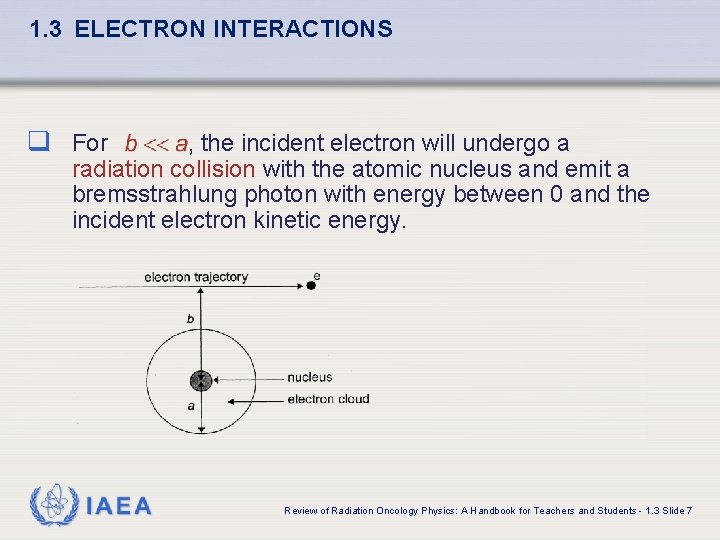
1. 3 ELECTRON INTERACTIONS q For , the incident electron will undergo a radiation collision with the atomic nucleus and emit a bremsstrahlung photon with energy between 0 and the incident electron kinetic energy. IAEA Review of Radiation Oncology Physics: A Handbook for Teachers and Students - 1. 3 Slide 7
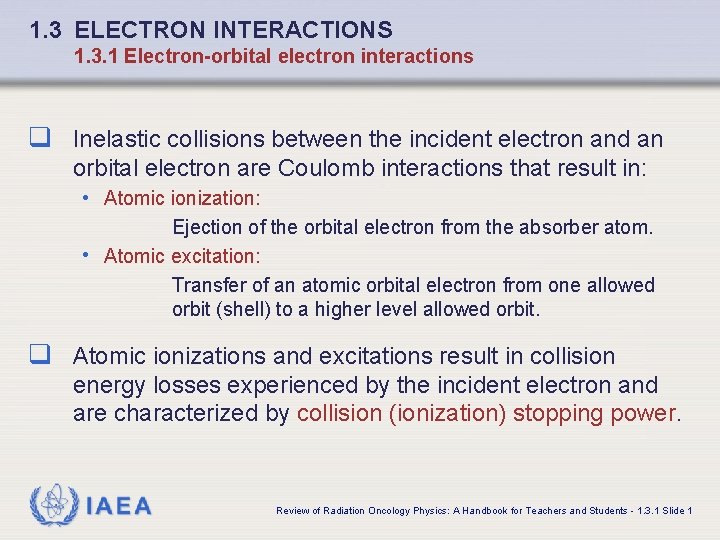
1. 3 ELECTRON INTERACTIONS 1. 3. 1 Electron-orbital electron interactions q Inelastic collisions between the incident electron and an orbital electron are Coulomb interactions that result in: • Atomic ionization: Ejection of the orbital electron from the absorber atom. • Atomic excitation: Transfer of an atomic orbital electron from one allowed orbit (shell) to a higher level allowed orbit. q Atomic ionizations and excitations result in collision energy losses experienced by the incident electron and are characterized by collision (ionization) stopping power. IAEA Review of Radiation Oncology Physics: A Handbook for Teachers and Students - 1. 3. 1 Slide 1

1. 3 ELECTRON INTERACTIONS 1. 3. 2 Electron-nucleus interaction q Coulomb interaction between the incident electron and an absorber nucleus results in: • Electron scattering and no energy loss (elastic collision): characterized by angular scattering power • Electron scattering and some loss of kinetic energy in the form of bremsstrahlung (radiation loss): characterized by radiation stopping power IAEA Review of Radiation Oncology Physics: A Handbook for Teachers and Students - 1. 3. 2 Slide 2
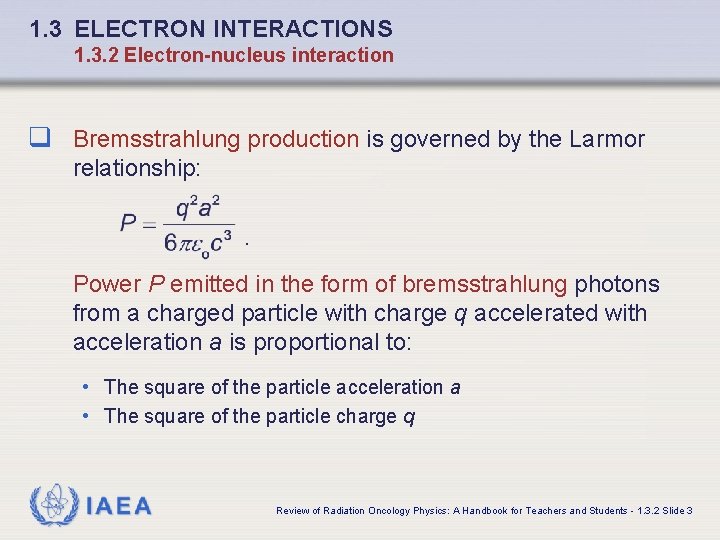
1. 3 ELECTRON INTERACTIONS 1. 3. 2 Electron-nucleus interaction q Bremsstrahlung production is governed by the Larmor relationship: . Power P emitted in the form of bremsstrahlung photons from a charged particle with charge q accelerated with acceleration a is proportional to: • The square of the particle acceleration a • The square of the particle charge q IAEA Review of Radiation Oncology Physics: A Handbook for Teachers and Students - 1. 3. 2 Slide 3
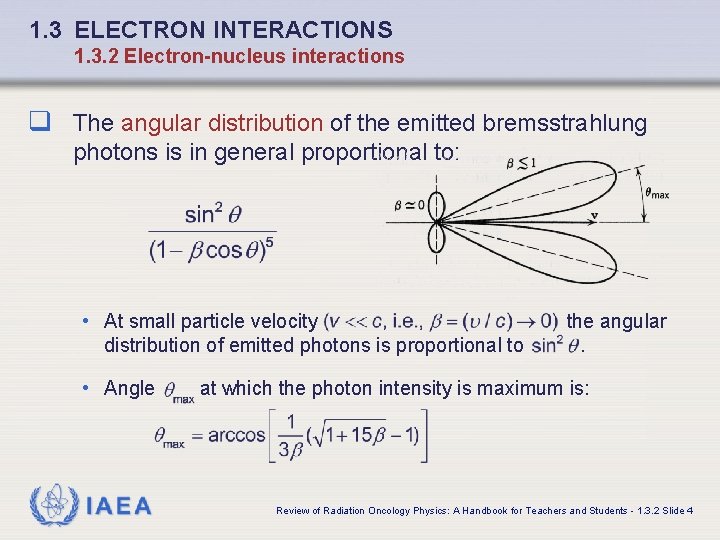
1. 3 ELECTRON INTERACTIONS 1. 3. 2 Electron-nucleus interactions q The angular distribution of the emitted bremsstrahlung photons is in general proportional to: • At small particle velocity distribution of emitted photons is proportional to • Angle IAEA the angular. at which the photon intensity is maximum is: Review of Radiation Oncology Physics: A Handbook for Teachers and Students - 1. 3. 2 Slide 4
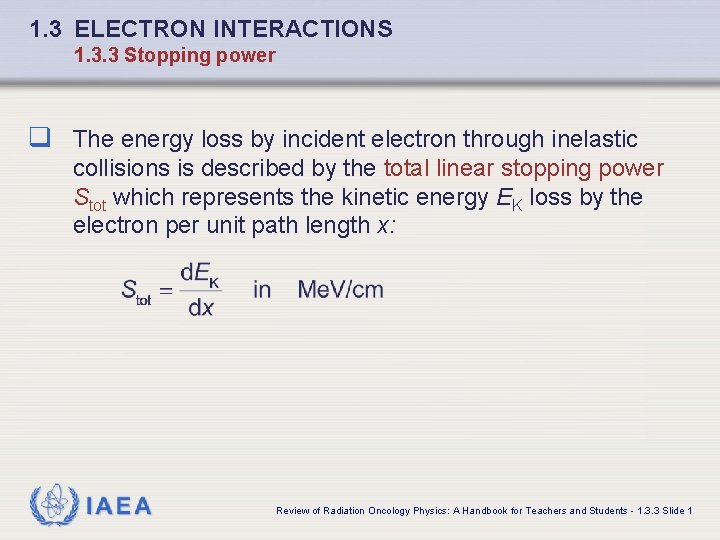
1. 3 ELECTRON INTERACTIONS 1. 3. 3 Stopping power q The energy loss by incident electron through inelastic collisions is described by the total linear stopping power Stot which represents the kinetic energy EK loss by the electron per unit path length x: IAEA Review of Radiation Oncology Physics: A Handbook for Teachers and Students - 1. 3. 3 Slide 1
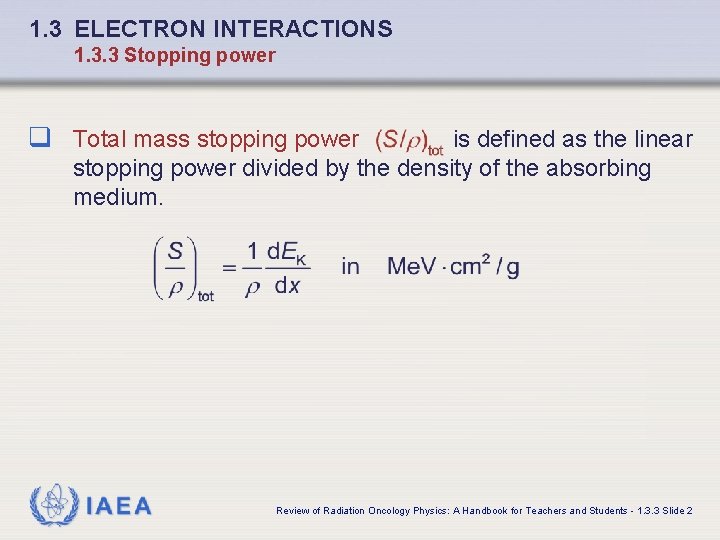
1. 3 ELECTRON INTERACTIONS 1. 3. 3 Stopping power q Total mass stopping power is defined as the linear stopping power divided by the density of the absorbing medium. IAEA Review of Radiation Oncology Physics: A Handbook for Teachers and Students - 1. 3. 3 Slide 2
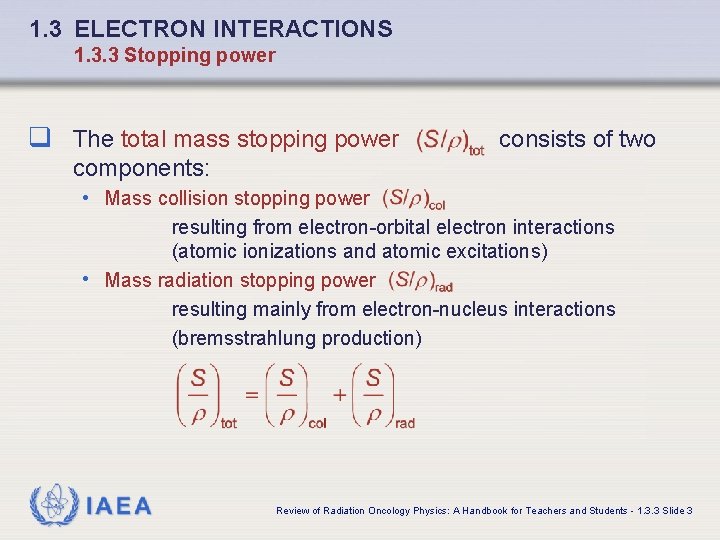
1. 3 ELECTRON INTERACTIONS 1. 3. 3 Stopping power q The total mass stopping power consists of two components: • Mass collision stopping power resulting from electron-orbital electron interactions (atomic ionizations and atomic excitations) • Mass radiation stopping power resulting mainly from electron-nucleus interactions (bremsstrahlung production) IAEA Review of Radiation Oncology Physics: A Handbook for Teachers and Students - 1. 3. 3 Slide 3
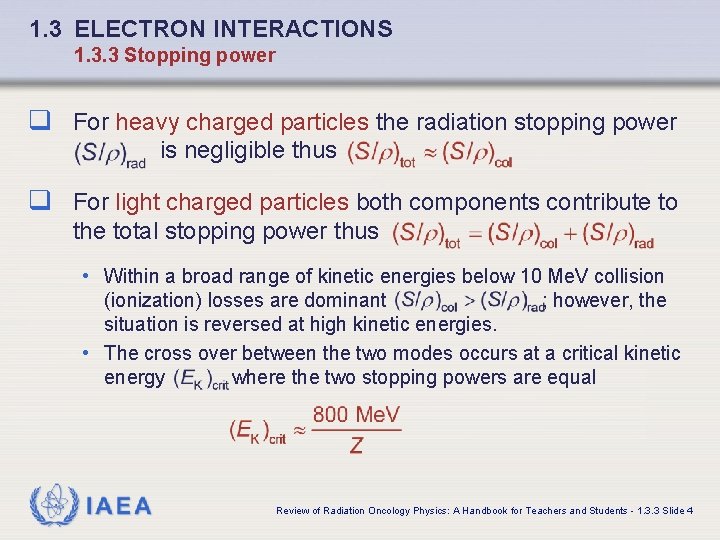
1. 3 ELECTRON INTERACTIONS 1. 3. 3 Stopping power q For heavy charged particles the radiation stopping power is negligible thus q For light charged particles both components contribute to the total stopping power thus • Within a broad range of kinetic energies below 10 Me. V collision (ionization) losses are dominant ; however, the situation is reversed at high kinetic energies. • The cross over between the two modes occurs at a critical kinetic energy where the two stopping powers are equal IAEA Review of Radiation Oncology Physics: A Handbook for Teachers and Students - 1. 3. 3 Slide 4
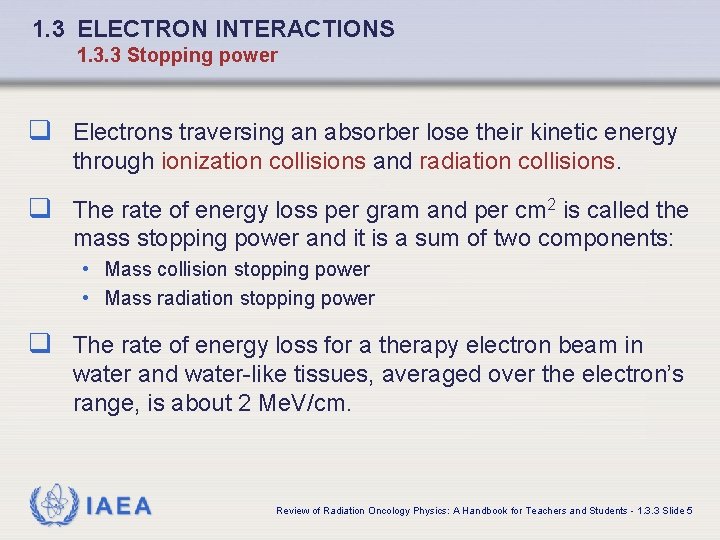
1. 3 ELECTRON INTERACTIONS 1. 3. 3 Stopping power q Electrons traversing an absorber lose their kinetic energy through ionization collisions and radiation collisions. q The rate of energy loss per gram and per cm 2 is called the mass stopping power and it is a sum of two components: • Mass collision stopping power • Mass radiation stopping power q The rate of energy loss for a therapy electron beam in water and water-like tissues, averaged over the electron’s range, is about 2 Me. V/cm. IAEA Review of Radiation Oncology Physics: A Handbook for Teachers and Students - 1. 3. 3 Slide 5
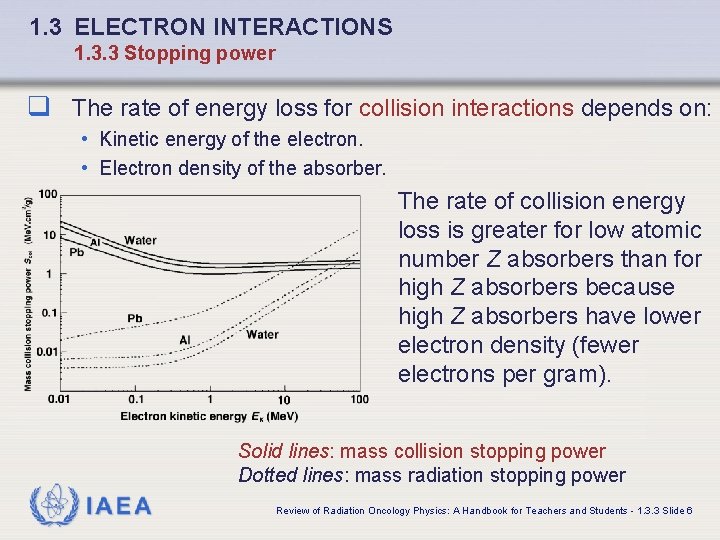
1. 3 ELECTRON INTERACTIONS 1. 3. 3 Stopping power q The rate of energy loss for collision interactions depends on: • Kinetic energy of the electron. • Electron density of the absorber. The rate of collision energy loss is greater for low atomic number Z absorbers than for high Z absorbers because high Z absorbers have lower electron density (fewer electrons per gram). Solid lines: mass collision stopping power Dotted lines: mass radiation stopping power IAEA Review of Radiation Oncology Physics: A Handbook for Teachers and Students - 1. 3. 3 Slide 6
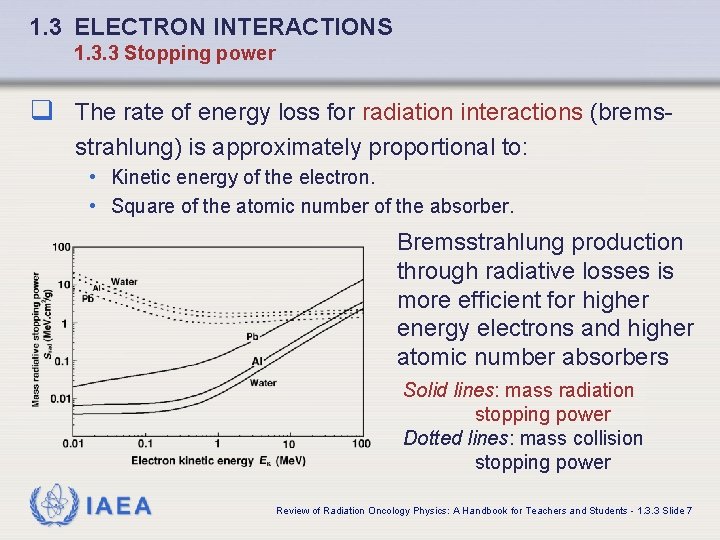
1. 3 ELECTRON INTERACTIONS 1. 3. 3 Stopping power q The rate of energy loss for radiation interactions (bremsstrahlung) is approximately proportional to: • Kinetic energy of the electron. • Square of the atomic number of the absorber. Bremsstrahlung production through radiative losses is more efficient for higher energy electrons and higher atomic number absorbers Solid lines: mass radiation stopping power Dotted lines: mass collision stopping power IAEA Review of Radiation Oncology Physics: A Handbook for Teachers and Students - 1. 3. 3 Slide 7
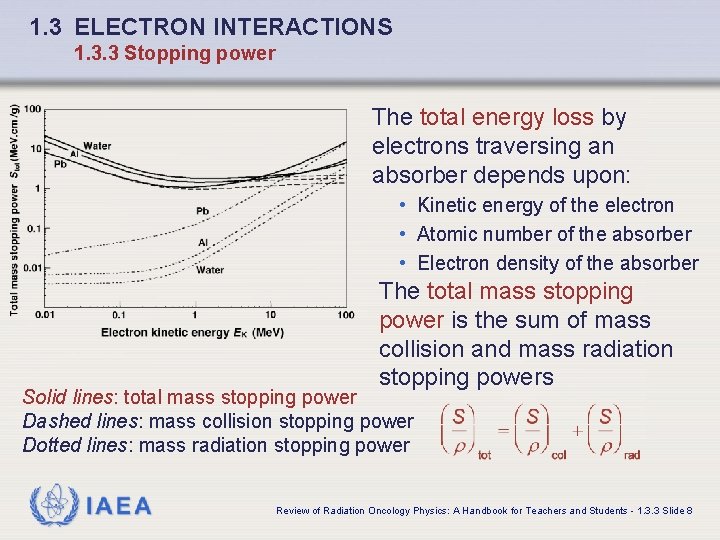
1. 3 ELECTRON INTERACTIONS 1. 3. 3 Stopping power The total energy loss by electrons traversing an absorber depends upon: • Kinetic energy of the electron • Atomic number of the absorber • Electron density of the absorber The total mass stopping power is the sum of mass collision and mass radiation stopping powers Solid lines: total mass stopping power Dashed lines: mass collision stopping power Dotted lines: mass radiation stopping power IAEA Review of Radiation Oncology Physics: A Handbook for Teachers and Students - 1. 3. 3 Slide 8
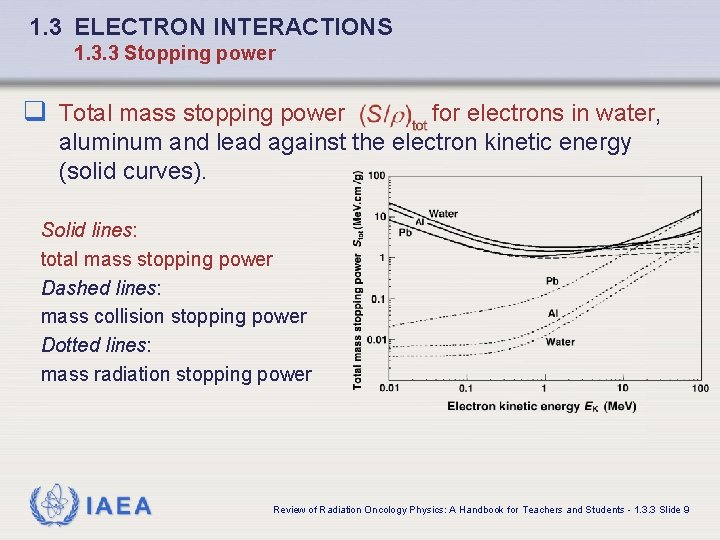
1. 3 ELECTRON INTERACTIONS 1. 3. 3 Stopping power q Total mass stopping power for electrons in water, aluminum and lead against the electron kinetic energy (solid curves). Solid lines: total mass stopping power Dashed lines: mass collision stopping power Dotted lines: mass radiation stopping power IAEA Review of Radiation Oncology Physics: A Handbook for Teachers and Students - 1. 3. 3 Slide 9
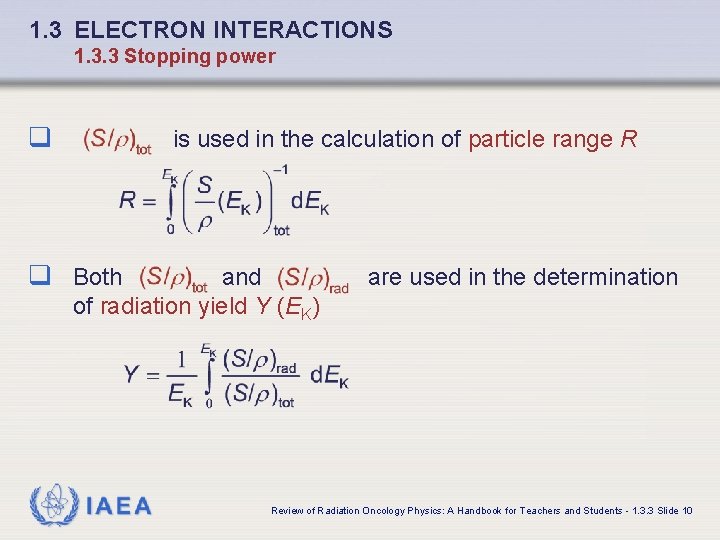
1. 3 ELECTRON INTERACTIONS 1. 3. 3 Stopping power q is used in the calculation of particle range R q Both and of radiation yield Y (EK) IAEA are used in the determination Review of Radiation Oncology Physics: A Handbook for Teachers and Students - 1. 3. 3 Slide 10
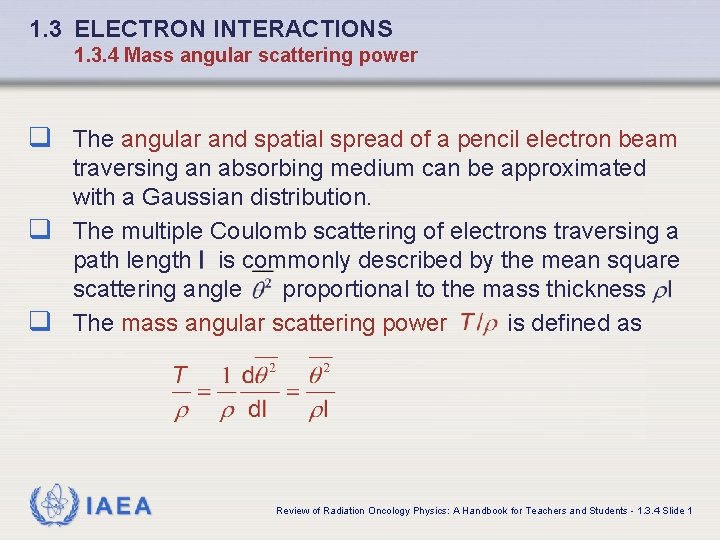
1. 3 ELECTRON INTERACTIONS 1. 3. 4 Mass angular scattering power q The angular and spatial spread of a pencil electron beam traversing an absorbing medium can be approximated with a Gaussian distribution. q The multiple Coulomb scattering of electrons traversing a path length is commonly described by the mean square scattering angle proportional to the mass thickness q The mass angular scattering power is defined as IAEA Review of Radiation Oncology Physics: A Handbook for Teachers and Students - 1. 3. 4 Slide 1
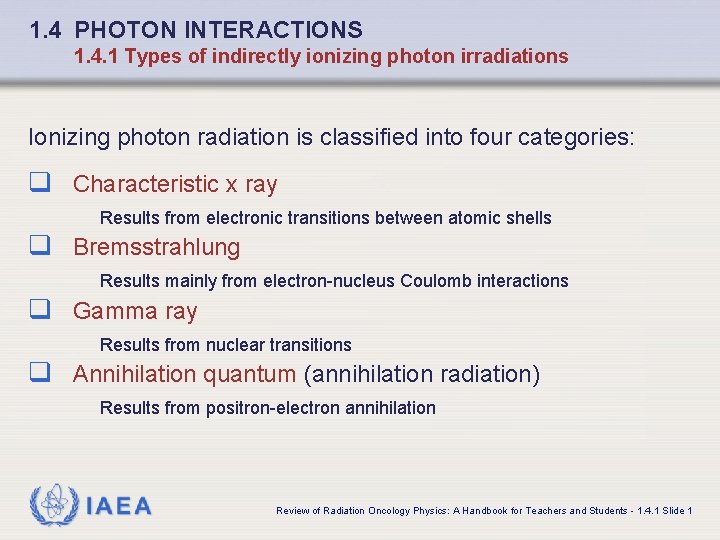
1. 4 PHOTON INTERACTIONS 1. 4. 1 Types of indirectly ionizing photon irradiations Ionizing photon radiation is classified into four categories: q Characteristic x ray Results from electronic transitions between atomic shells q Bremsstrahlung Results mainly from electron-nucleus Coulomb interactions q Gamma ray Results from nuclear transitions q Annihilation quantum (annihilation radiation) Results from positron-electron annihilation IAEA Review of Radiation Oncology Physics: A Handbook for Teachers and Students - 1. 4. 1 Slide 1
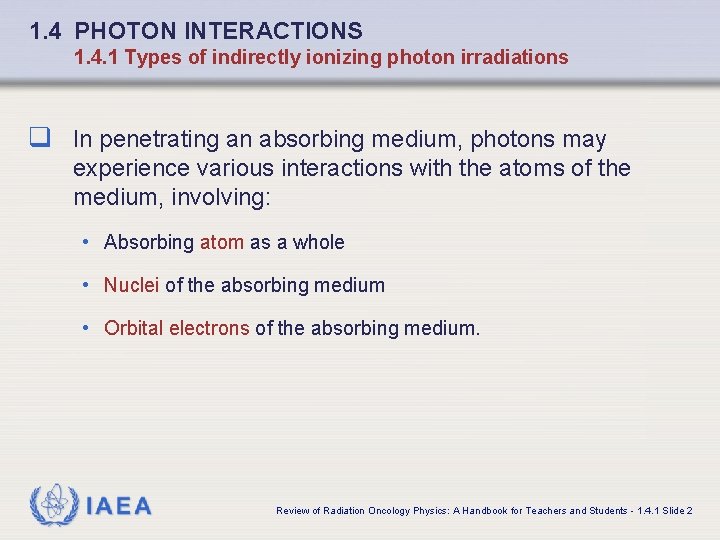
1. 4 PHOTON INTERACTIONS 1. 4. 1 Types of indirectly ionizing photon irradiations q In penetrating an absorbing medium, photons may experience various interactions with the atoms of the medium, involving: • Absorbing atom as a whole • Nuclei of the absorbing medium • Orbital electrons of the absorbing medium. IAEA Review of Radiation Oncology Physics: A Handbook for Teachers and Students - 1. 4. 1 Slide 2
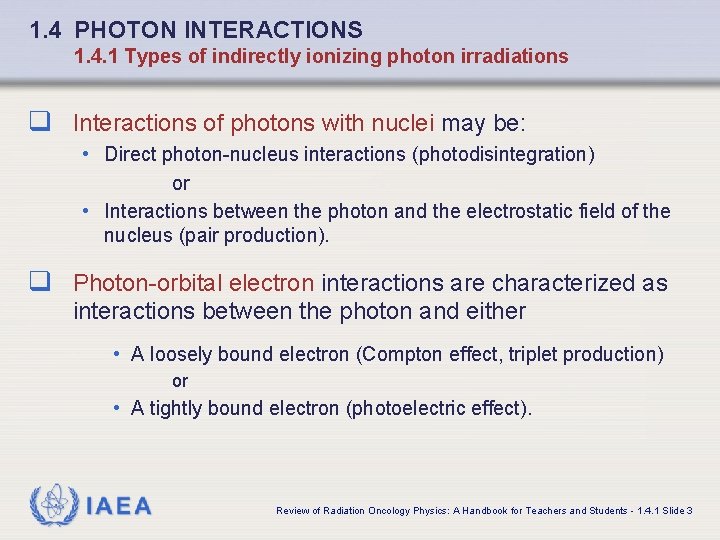
1. 4 PHOTON INTERACTIONS 1. 4. 1 Types of indirectly ionizing photon irradiations q Interactions of photons with nuclei may be: • Direct photon-nucleus interactions (photodisintegration) or • Interactions between the photon and the electrostatic field of the nucleus (pair production). q Photon-orbital electron interactions are characterized as interactions between the photon and either • A loosely bound electron (Compton effect, triplet production) or • A tightly bound electron (photoelectric effect). IAEA Review of Radiation Oncology Physics: A Handbook for Teachers and Students - 1. 4. 1 Slide 3
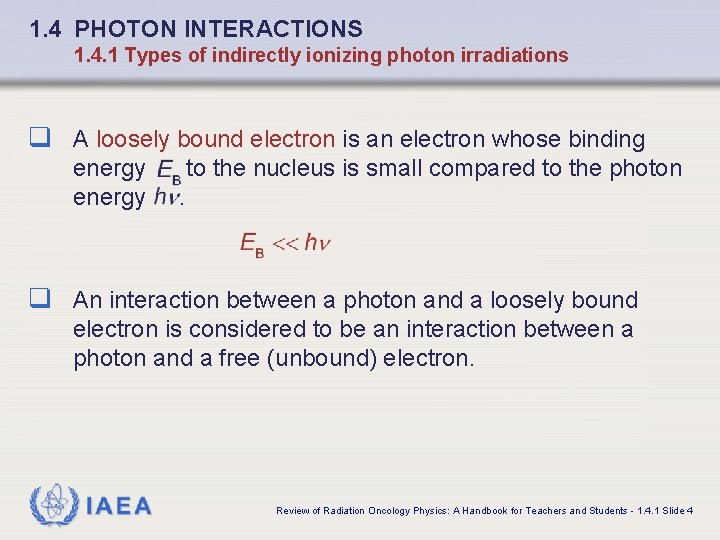
1. 4 PHOTON INTERACTIONS 1. 4. 1 Types of indirectly ionizing photon irradiations q A loosely bound electron is an electron whose binding energy to the nucleus is small compared to the photon. q An interaction between a photon and a loosely bound electron is considered to be an interaction between a photon and a free (unbound) electron. IAEA Review of Radiation Oncology Physics: A Handbook for Teachers and Students - 1. 4. 1 Slide 4
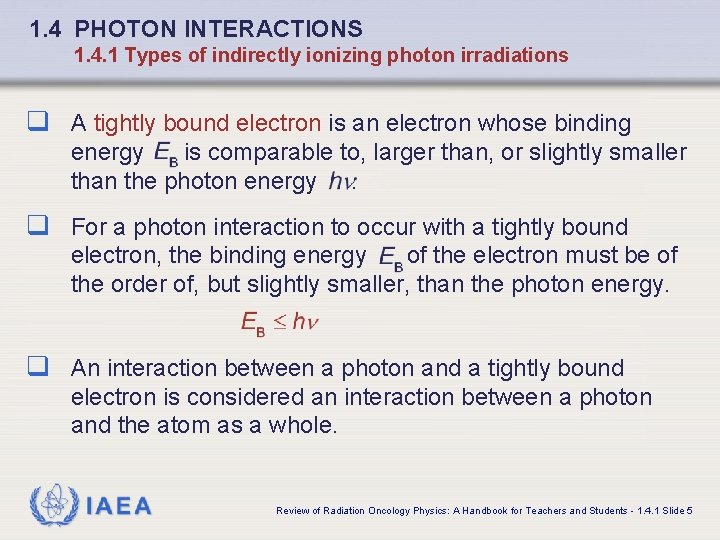
1. 4 PHOTON INTERACTIONS 1. 4. 1 Types of indirectly ionizing photon irradiations q A tightly bound electron is an electron whose binding energy is comparable to, larger than, or slightly smaller than the photon energy. q For a photon interaction to occur with a tightly bound electron, the binding energy of the electron must be of the order of, but slightly smaller, than the photon energy. q An interaction between a photon and a tightly bound electron is considered an interaction between a photon and the atom as a whole. IAEA Review of Radiation Oncology Physics: A Handbook for Teachers and Students - 1. 4. 1 Slide 5
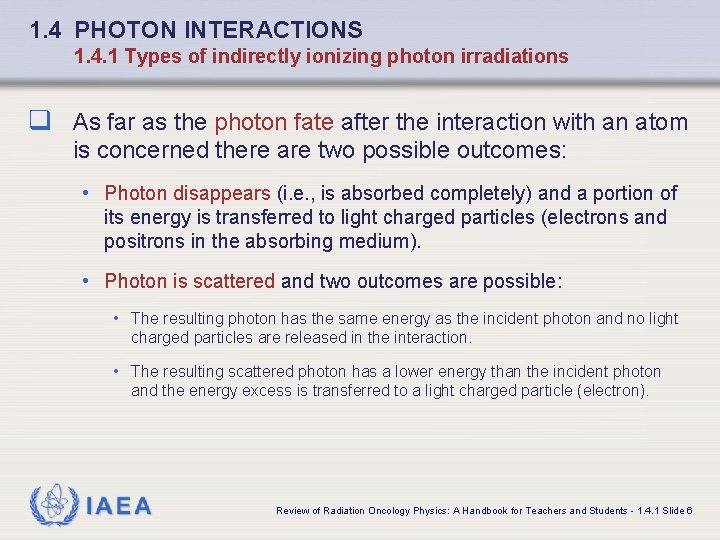
1. 4 PHOTON INTERACTIONS 1. 4. 1 Types of indirectly ionizing photon irradiations q As far as the photon fate after the interaction with an atom is concerned there are two possible outcomes: • Photon disappears (i. e. , is absorbed completely) and a portion of its energy is transferred to light charged particles (electrons and positrons in the absorbing medium). • Photon is scattered and two outcomes are possible: • The resulting photon has the same energy as the incident photon and no light charged particles are released in the interaction. • The resulting scattered photon has a lower energy than the incident photon and the energy excess is transferred to a light charged particle (electron). IAEA Review of Radiation Oncology Physics: A Handbook for Teachers and Students - 1. 4. 1 Slide 6
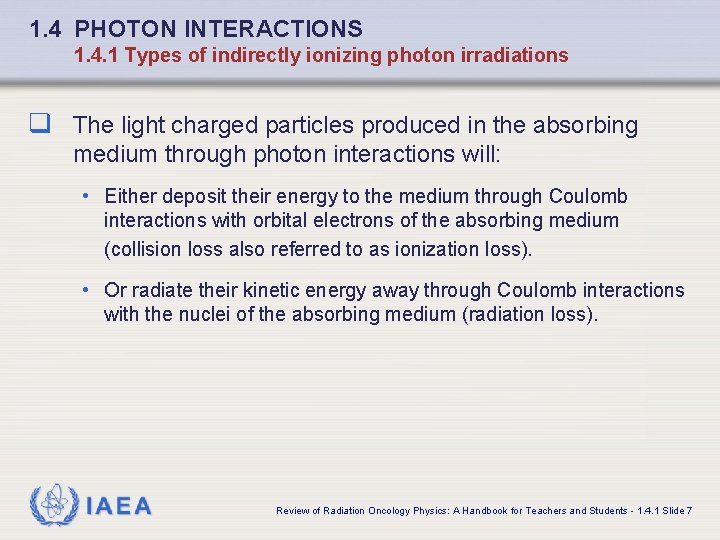
1. 4 PHOTON INTERACTIONS 1. 4. 1 Types of indirectly ionizing photon irradiations q The light charged particles produced in the absorbing medium through photon interactions will: • Either deposit their energy to the medium through Coulomb interactions with orbital electrons of the absorbing medium (collision loss also referred to as ionization loss). • Or radiate their kinetic energy away through Coulomb interactions with the nuclei of the absorbing medium (radiation loss). IAEA Review of Radiation Oncology Physics: A Handbook for Teachers and Students - 1. 4. 1 Slide 7
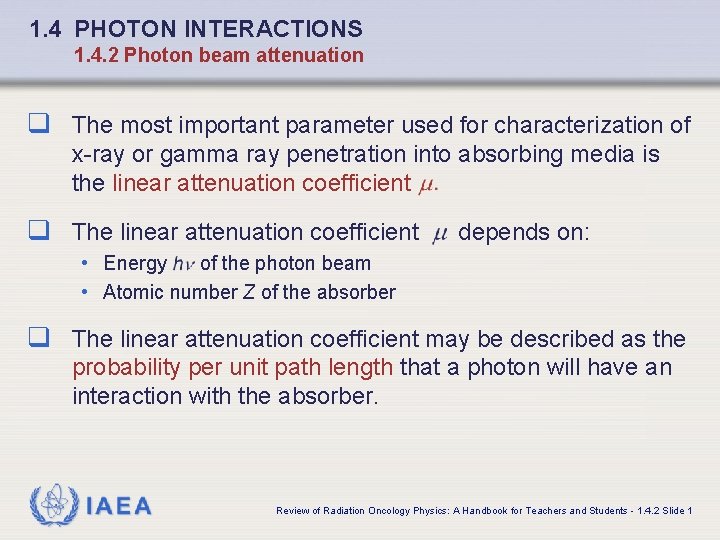
1. 4 PHOTON INTERACTIONS 1. 4. 2 Photon beam attenuation q The most important parameter used for characterization of x-ray or gamma ray penetration into absorbing media is the linear attenuation coefficient q The linear attenuation coefficient depends on: • Energy of the photon beam • Atomic number Z of the absorber q The linear attenuation coefficient may be described as the probability per unit path length that a photon will have an interaction with the absorber. IAEA Review of Radiation Oncology Physics: A Handbook for Teachers and Students - 1. 4. 2 Slide 1
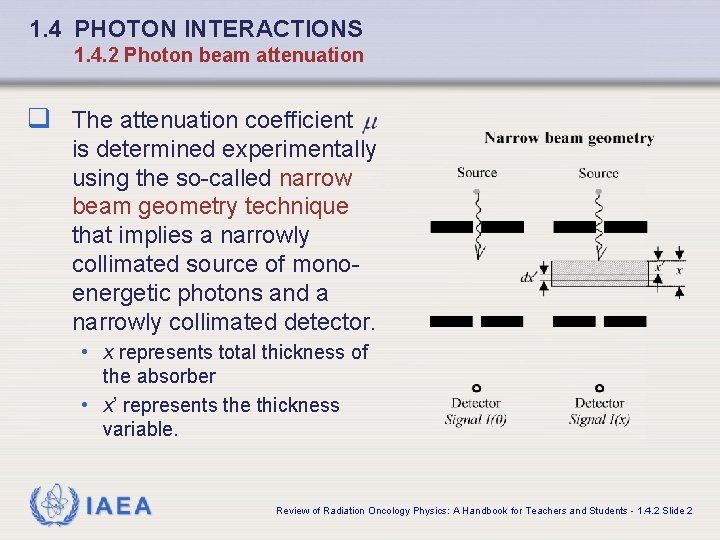
1. 4 PHOTON INTERACTIONS 1. 4. 2 Photon beam attenuation q The attenuation coefficient is determined experimentally using the so-called narrow beam geometry technique that implies a narrowly collimated source of monoenergetic photons and a narrowly collimated detector. • x represents total thickness of the absorber • x’ represents the thickness variable. IAEA Review of Radiation Oncology Physics: A Handbook for Teachers and Students - 1. 4. 2 Slide 2
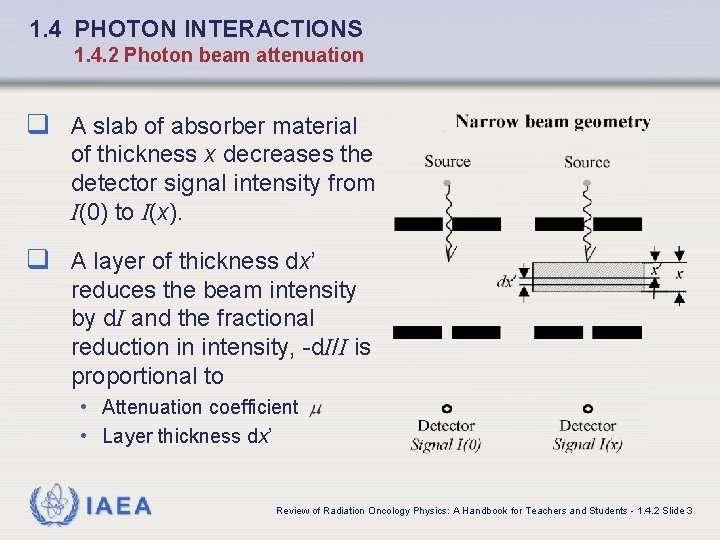
1. 4 PHOTON INTERACTIONS 1. 4. 2 Photon beam attenuation q A slab of absorber material of thickness x decreases the detector signal intensity from I(0) to I(x). q A layer of thickness dx’ reduces the beam intensity by d. I and the fractional reduction in intensity, -d. I/I is proportional to • Attenuation coefficient • Layer thickness dx’ IAEA Review of Radiation Oncology Physics: A Handbook for Teachers and Students - 1. 4. 2 Slide 3
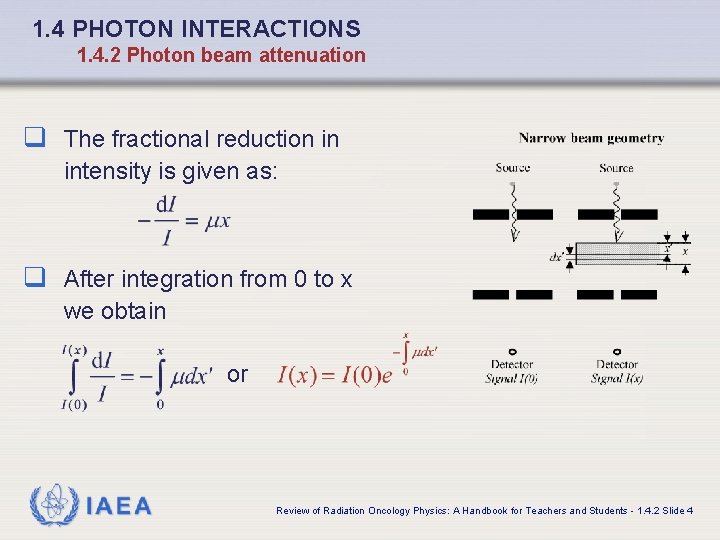
1. 4 PHOTON INTERACTIONS 1. 4. 2 Photon beam attenuation q The fractional reduction in intensity is given as: q After integration from 0 to x we obtain or IAEA Review of Radiation Oncology Physics: A Handbook for Teachers and Students - 1. 4. 2 Slide 4
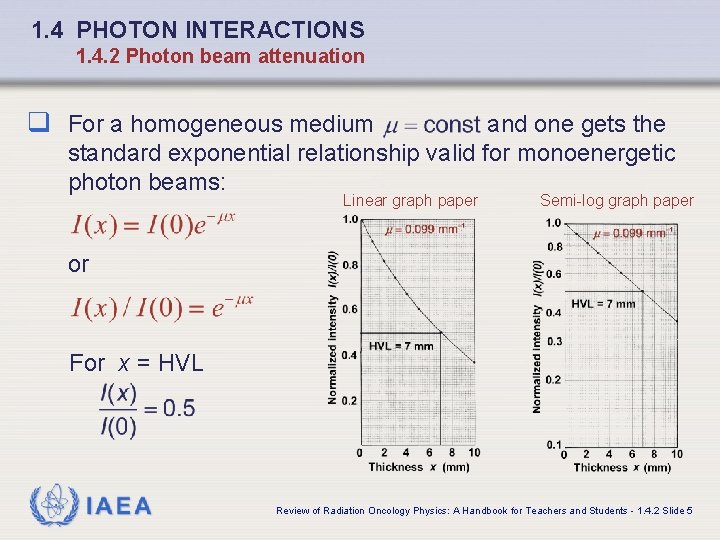
1. 4 PHOTON INTERACTIONS 1. 4. 2 Photon beam attenuation q For a homogeneous medium and one gets the standard exponential relationship valid for monoenergetic photon beams: Linear graph paper Semi-log graph paper or For x = HVL IAEA Review of Radiation Oncology Physics: A Handbook for Teachers and Students - 1. 4. 2 Slide 5
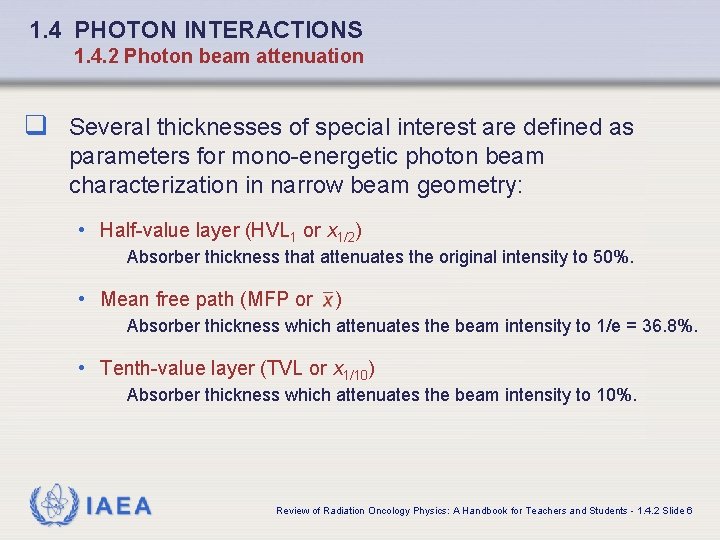
1. 4 PHOTON INTERACTIONS 1. 4. 2 Photon beam attenuation q Several thicknesses of special interest are defined as parameters for mono-energetic photon beam characterization in narrow beam geometry: • Half-value layer (HVL 1 or x 1/2) Absorber thickness that attenuates the original intensity to 50%. • Mean free path (MFP or ) Absorber thickness which attenuates the beam intensity to 1/e = 36. 8%. • Tenth-value layer (TVL or x 1/10) Absorber thickness which attenuates the beam intensity to 10%. IAEA Review of Radiation Oncology Physics: A Handbook for Teachers and Students - 1. 4. 2 Slide 6
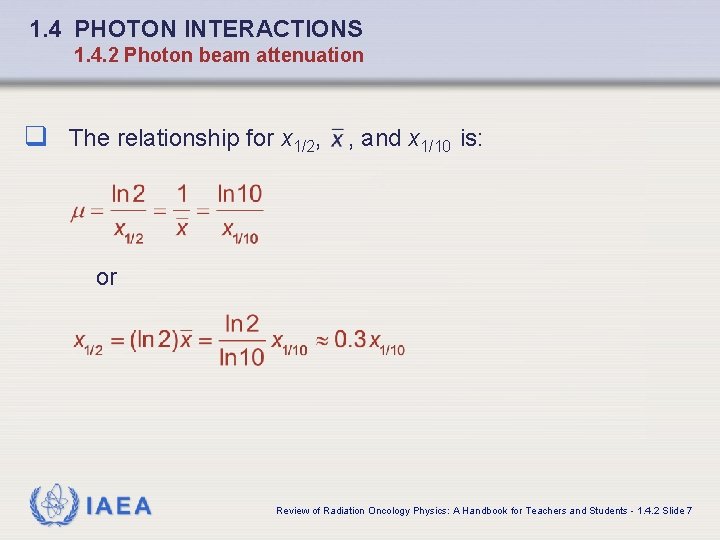
1. 4 PHOTON INTERACTIONS 1. 4. 2 Photon beam attenuation q The relationship for x 1/2, , and x 1/10 is: or IAEA Review of Radiation Oncology Physics: A Handbook for Teachers and Students - 1. 4. 2 Slide 7
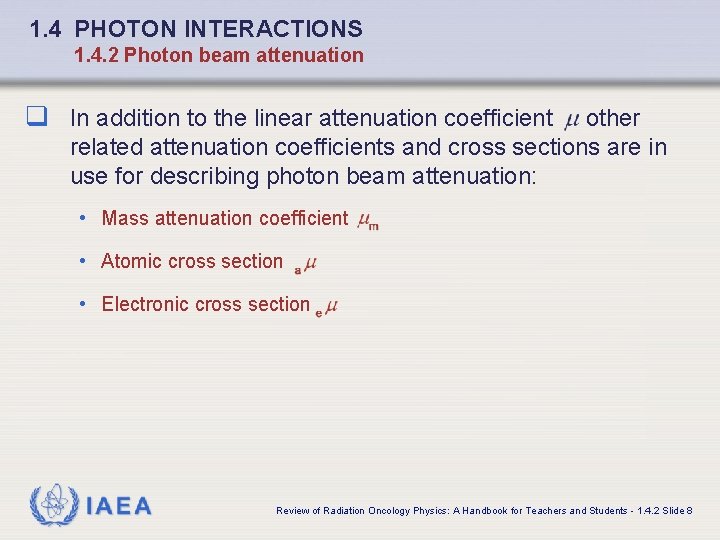
1. 4 PHOTON INTERACTIONS 1. 4. 2 Photon beam attenuation q In addition to the linear attenuation coefficient other related attenuation coefficients and cross sections are in use for describing photon beam attenuation: • Mass attenuation coefficient • Atomic cross section • Electronic cross section IAEA Review of Radiation Oncology Physics: A Handbook for Teachers and Students - 1. 4. 2 Slide 8
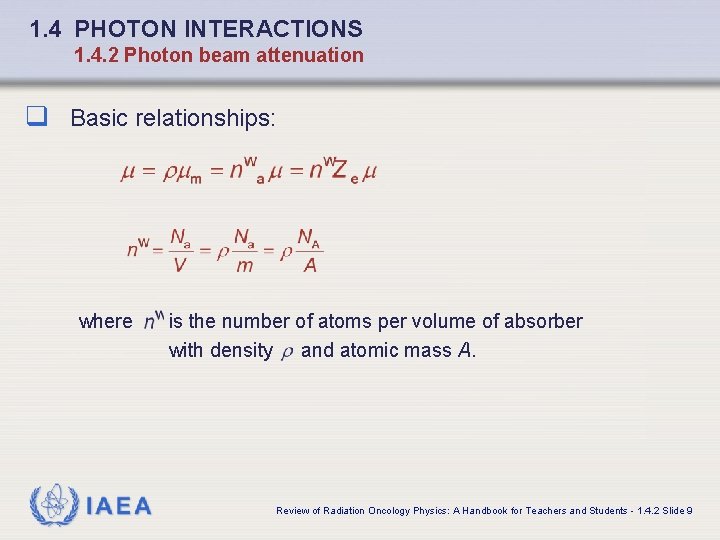
1. 4 PHOTON INTERACTIONS 1. 4. 2 Photon beam attenuation q Basic relationships: where IAEA is the number of atoms per volume of absorber with density and atomic mass A. Review of Radiation Oncology Physics: A Handbook for Teachers and Students - 1. 4. 2 Slide 9
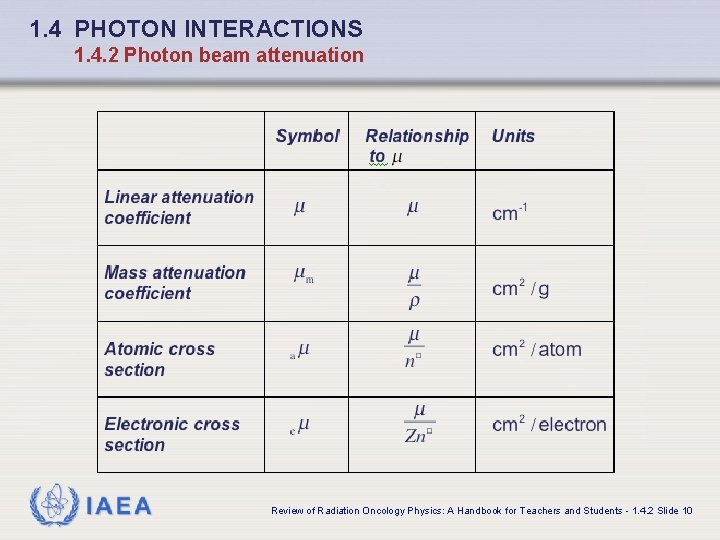
1. 4 PHOTON INTERACTIONS 1. 4. 2 Photon beam attenuation IAEA Review of Radiation Oncology Physics: A Handbook for Teachers and Students - 1. 4. 2 Slide 10
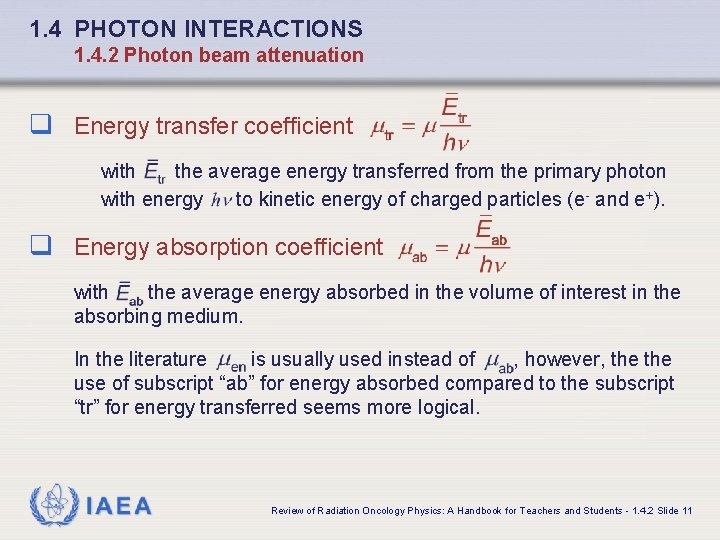
1. 4 PHOTON INTERACTIONS 1. 4. 2 Photon beam attenuation q Energy transfer coefficient with the average energy transferred from the primary photon with energy to kinetic energy of charged particles (e- and e+). q Energy absorption coefficient with the average energy absorbed in the volume of interest in the absorbing medium. In the literature is usually used instead of , however, the use of subscript “ab” for energy absorbed compared to the subscript “tr” for energy transferred seems more logical. IAEA Review of Radiation Oncology Physics: A Handbook for Teachers and Students - 1. 4. 2 Slide 11
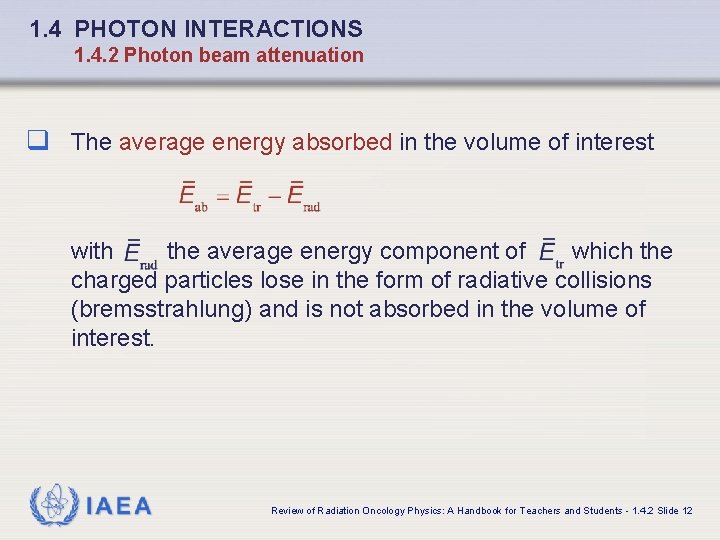
1. 4 PHOTON INTERACTIONS 1. 4. 2 Photon beam attenuation q The average energy absorbed in the volume of interest with the average energy component of which the charged particles lose in the form of radiative collisions (bremsstrahlung) and is not absorbed in the volume of interest. IAEA Review of Radiation Oncology Physics: A Handbook for Teachers and Students - 1. 4. 2 Slide 12
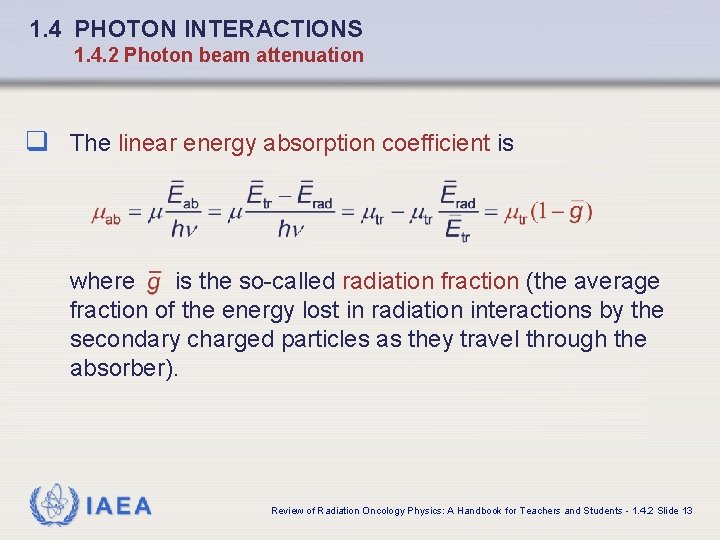
1. 4 PHOTON INTERACTIONS 1. 4. 2 Photon beam attenuation q The linear energy absorption coefficient is where is the so-called radiation fraction (the average fraction of the energy lost in radiation interactions by the secondary charged particles as they travel through the absorber). IAEA Review of Radiation Oncology Physics: A Handbook for Teachers and Students - 1. 4. 2 Slide 13
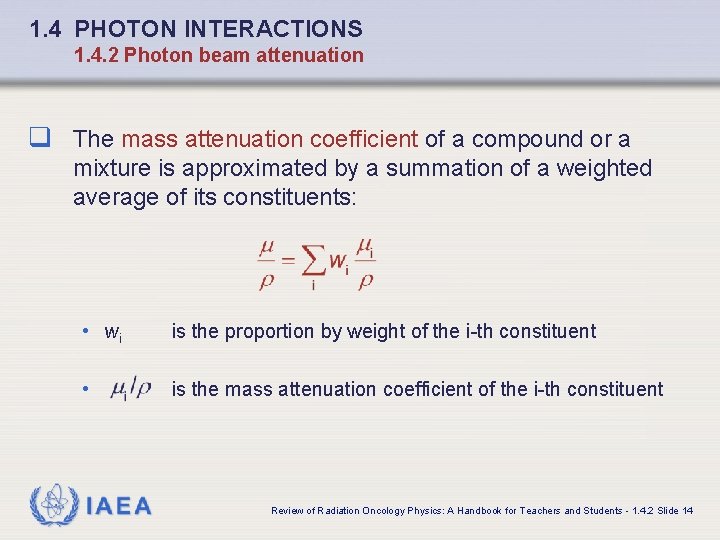
1. 4 PHOTON INTERACTIONS 1. 4. 2 Photon beam attenuation q The mass attenuation coefficient of a compound or a mixture is approximated by a summation of a weighted average of its constituents: • wi is the proportion by weight of the i-th constituent • is the mass attenuation coefficient of the i-th constituent IAEA Review of Radiation Oncology Physics: A Handbook for Teachers and Students - 1. 4. 2 Slide 14
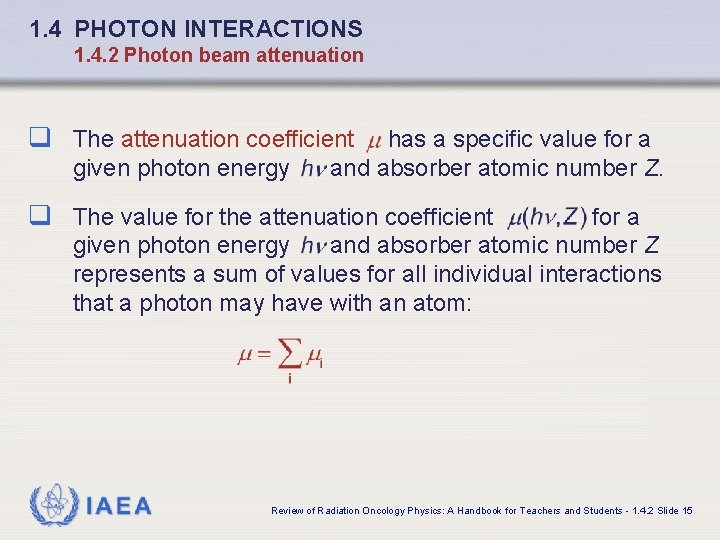
1. 4 PHOTON INTERACTIONS 1. 4. 2 Photon beam attenuation q The attenuation coefficient given photon energy has a specific value for a and absorber atomic number Z. q The value for the attenuation coefficient for a given photon energy and absorber atomic number Z represents a sum of values for all individual interactions that a photon may have with an atom: IAEA Review of Radiation Oncology Physics: A Handbook for Teachers and Students - 1. 4. 2 Slide 15
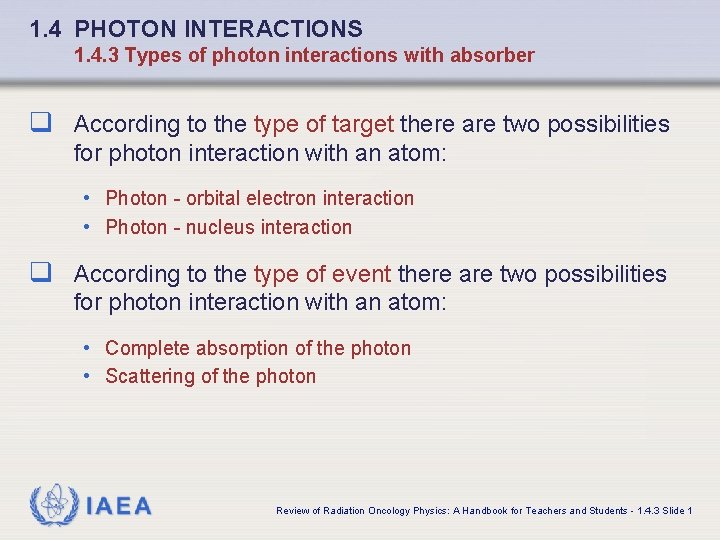
1. 4 PHOTON INTERACTIONS 1. 4. 3 Types of photon interactions with absorber q According to the type of target there are two possibilities for photon interaction with an atom: • Photon - orbital electron interaction • Photon - nucleus interaction q According to the type of event there are two possibilities for photon interaction with an atom: • Complete absorption of the photon • Scattering of the photon IAEA Review of Radiation Oncology Physics: A Handbook for Teachers and Students - 1. 4. 3 Slide 1
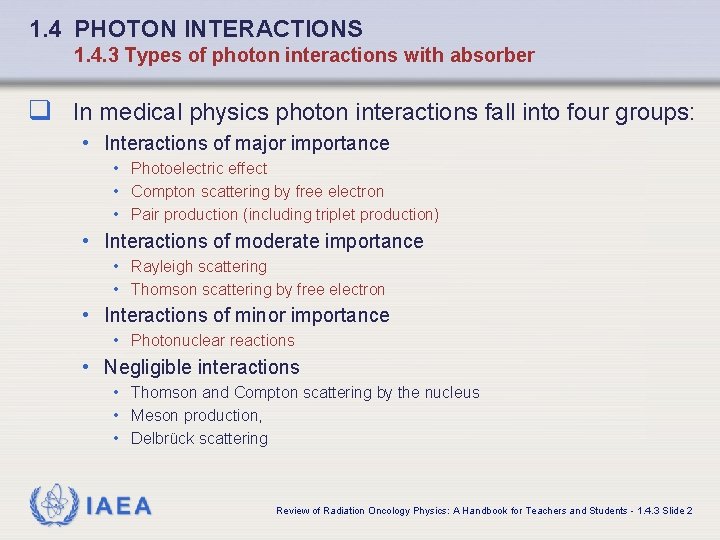
1. 4 PHOTON INTERACTIONS 1. 4. 3 Types of photon interactions with absorber q In medical physics photon interactions fall into four groups: • Interactions of major importance • Photoelectric effect • Compton scattering by free electron • Pair production (including triplet production) • Interactions of moderate importance • Rayleigh scattering • Thomson scattering by free electron • Interactions of minor importance • Photonuclear reactions • Negligible interactions • Thomson and Compton scattering by the nucleus • Meson production, • Delbrück scattering IAEA Review of Radiation Oncology Physics: A Handbook for Teachers and Students - 1. 4. 3 Slide 2
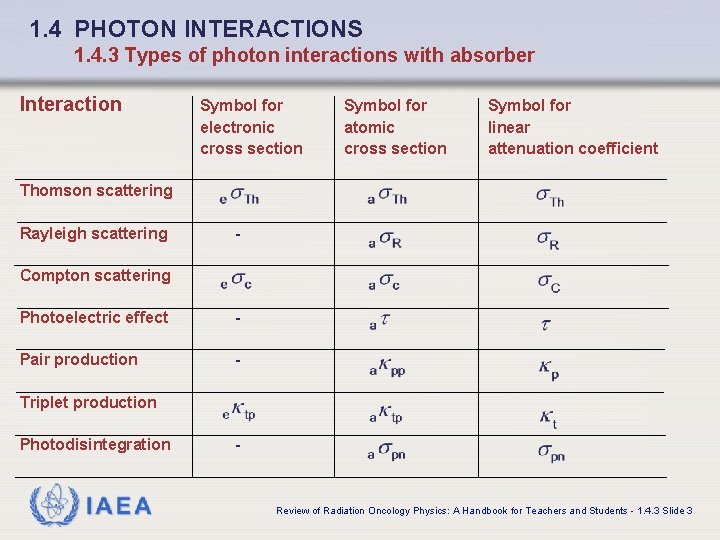
1. 4 PHOTON INTERACTIONS 1. 4. 3 Types of photon interactions with absorber Interaction Symbol for electronic cross section Symbol for atomic cross section Symbol for linear attenuation coefficient Thomson scattering Rayleigh scattering - Compton scattering Photoelectric effect - Pair production - Triplet production Photodisintegration IAEA - Review of Radiation Oncology Physics: A Handbook for Teachers and Students - 1. 4. 3 Slide 3
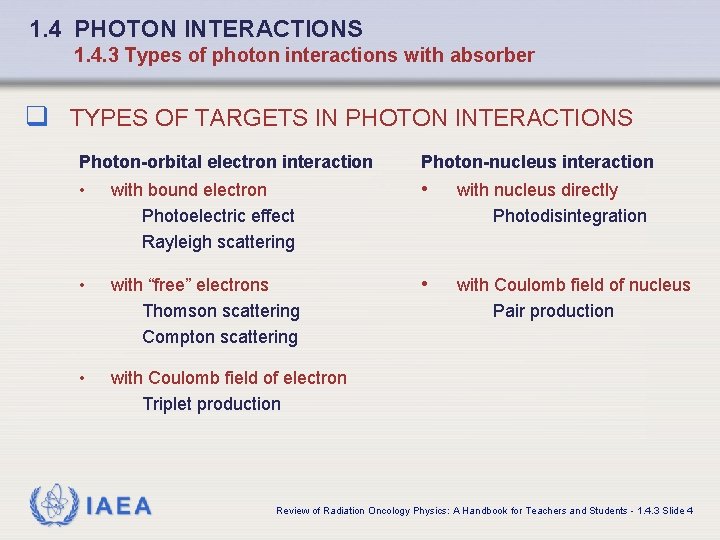
1. 4 PHOTON INTERACTIONS 1. 4. 3 Types of photon interactions with absorber q TYPES OF TARGETS IN PHOTON INTERACTIONS Photon-orbital electron interaction Photon-nucleus interaction • with bound electron Photoelectric effect Rayleigh scattering • with nucleus directly Photodisintegration • with “free” electrons Thomson scattering Compton scattering • with Coulomb field of nucleus Pair production • with Coulomb field of electron Triplet production IAEA Review of Radiation Oncology Physics: A Handbook for Teachers and Students - 1. 4. 3 Slide 4
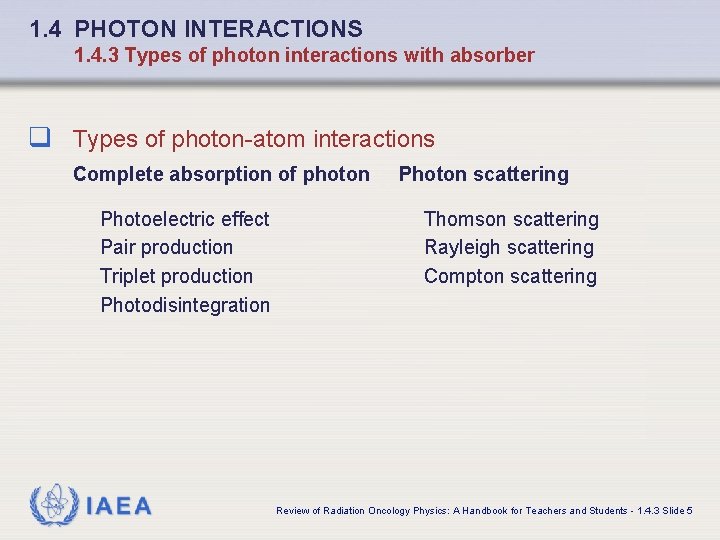
1. 4 PHOTON INTERACTIONS 1. 4. 3 Types of photon interactions with absorber q Types of photon-atom interactions Complete absorption of photon Photoelectric effect Pair production Triplet production Photodisintegration IAEA Photon scattering Thomson scattering Rayleigh scattering Compton scattering Review of Radiation Oncology Physics: A Handbook for Teachers and Students - 1. 4. 3 Slide 5
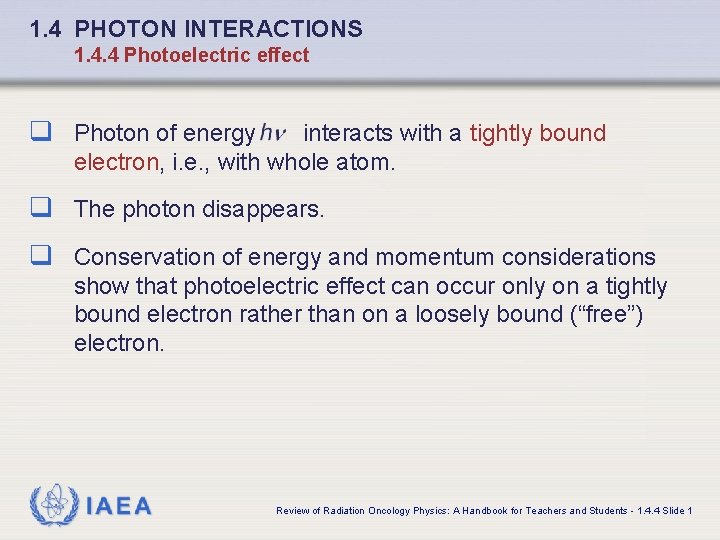
1. 4 PHOTON INTERACTIONS 1. 4. 4 Photoelectric effect q Photon of energy interacts with a tightly bound electron, i. e. , with whole atom. q The photon disappears. q Conservation of energy and momentum considerations show that photoelectric effect can occur only on a tightly bound electron rather than on a loosely bound (“free”) electron. IAEA Review of Radiation Oncology Physics: A Handbook for Teachers and Students - 1. 4. 4 Slide 1
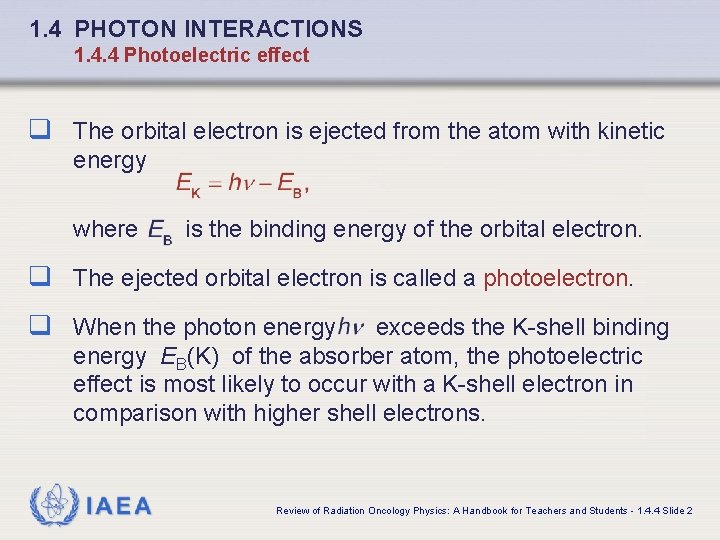
1. 4 PHOTON INTERACTIONS 1. 4. 4 Photoelectric effect q The orbital electron is ejected from the atom with kinetic energy where is the binding energy of the orbital electron. q The ejected orbital electron is called a photoelectron. q When the photon energy exceeds the K-shell binding energy EB(K) of the absorber atom, the photoelectric effect is most likely to occur with a K-shell electron in comparison with higher shell electrons. IAEA Review of Radiation Oncology Physics: A Handbook for Teachers and Students - 1. 4. 4 Slide 2
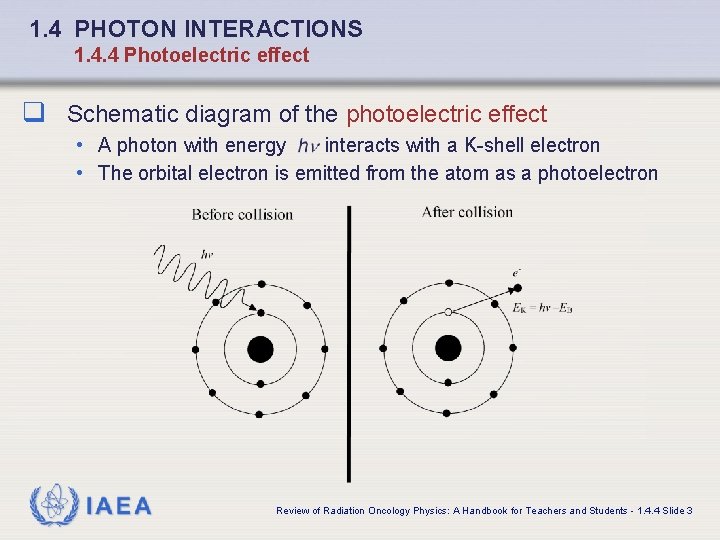
1. 4 PHOTON INTERACTIONS 1. 4. 4 Photoelectric effect q Schematic diagram of the photoelectric effect • A photon with energy interacts with a K-shell electron • The orbital electron is emitted from the atom as a photoelectron IAEA Review of Radiation Oncology Physics: A Handbook for Teachers and Students - 1. 4. 4 Slide 3
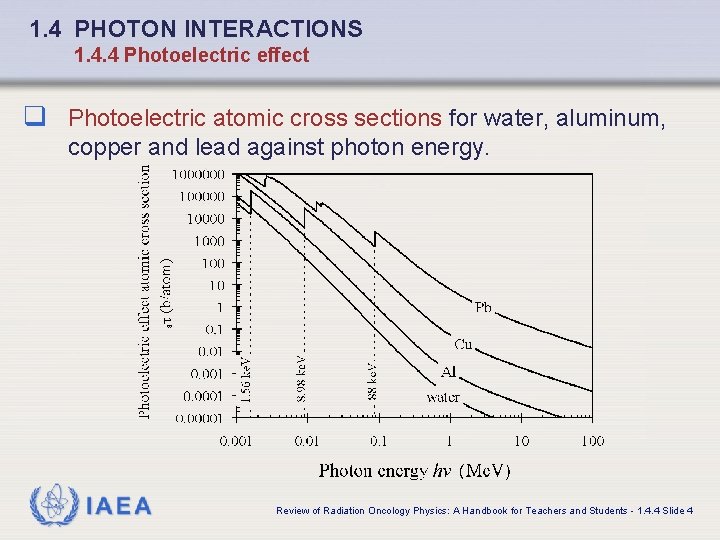
1. 4 PHOTON INTERACTIONS 1. 4. 4 Photoelectric effect q Photoelectric atomic cross sections for water, aluminum, copper and lead against photon energy. IAEA Review of Radiation Oncology Physics: A Handbook for Teachers and Students - 1. 4. 4 Slide 4
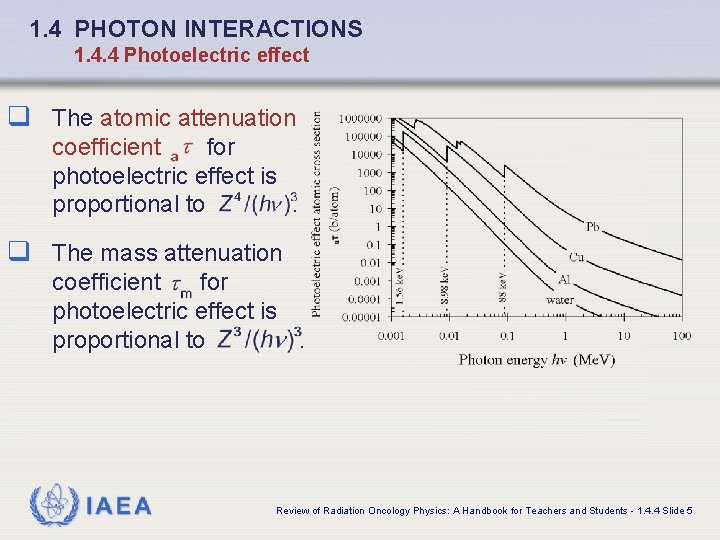
1. 4 PHOTON INTERACTIONS 1. 4. 4 Photoelectric effect q The atomic attenuation coefficient for photoelectric effect is proportional to. q The mass attenuation coefficient for photoelectric effect is proportional to. IAEA Review of Radiation Oncology Physics: A Handbook for Teachers and Students - 1. 4. 4 Slide 5
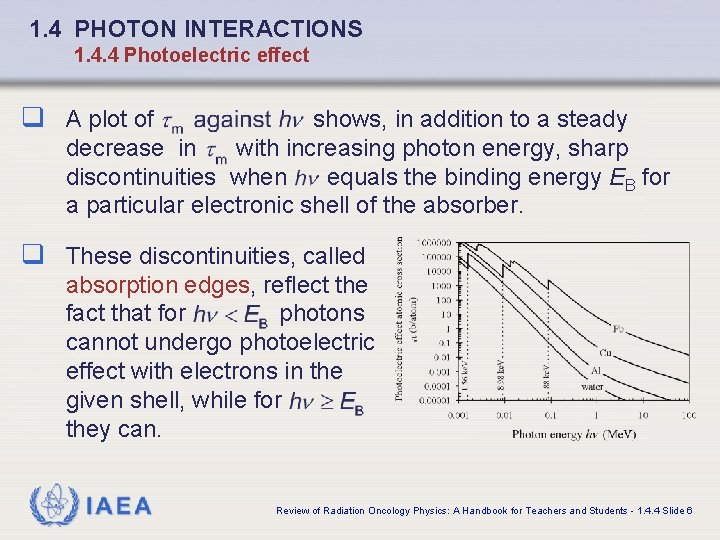
1. 4 PHOTON INTERACTIONS 1. 4. 4 Photoelectric effect q A plot of shows, in addition to a steady decrease in with increasing photon energy, sharp discontinuities when equals the binding energy EB for a particular electronic shell of the absorber. q These discontinuities, called absorption edges, reflect the fact that for photons cannot undergo photoelectric effect with electrons in the given shell, while for they can. IAEA Review of Radiation Oncology Physics: A Handbook for Teachers and Students - 1. 4. 4 Slide 6
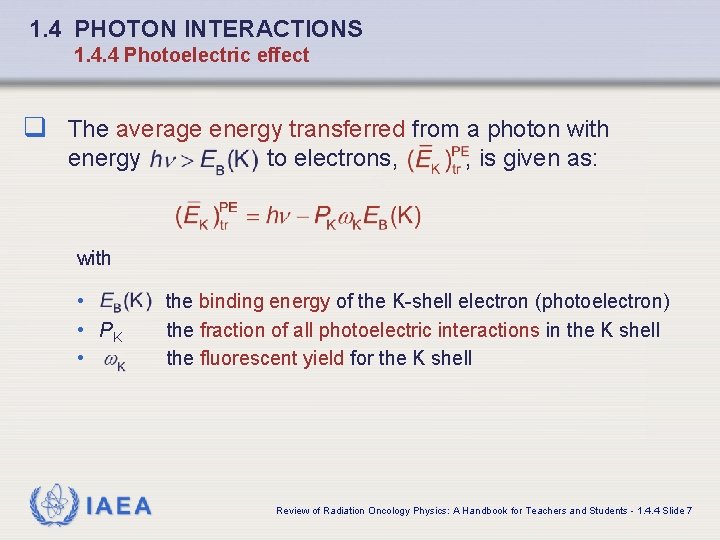
1. 4 PHOTON INTERACTIONS 1. 4. 4 Photoelectric effect q The average energy transferred from a photon with energy to electrons, , is given as: with • • PK • IAEA the binding energy of the K-shell electron (photoelectron) the fraction of all photoelectric interactions in the K shell the fluorescent yield for the K shell Review of Radiation Oncology Physics: A Handbook for Teachers and Students - 1. 4. 4 Slide 7
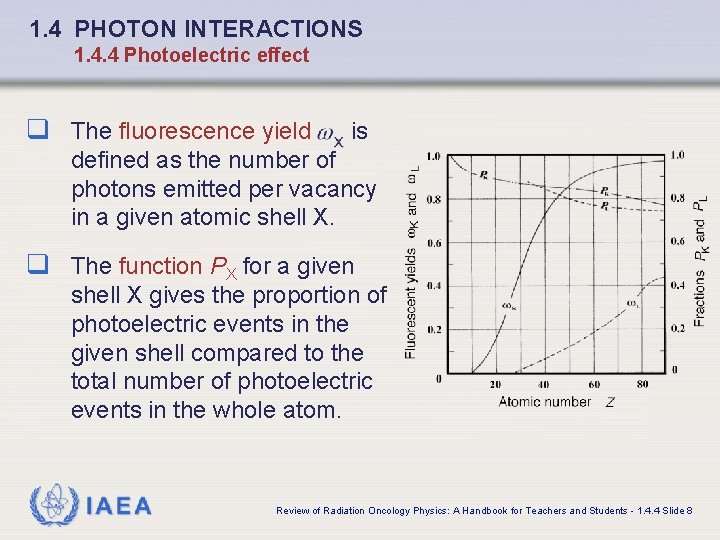
1. 4 PHOTON INTERACTIONS 1. 4. 4 Photoelectric effect q The fluorescence yield is defined as the number of photons emitted per vacancy in a given atomic shell X. q The function PX for a given shell X gives the proportion of photoelectric events in the given shell compared to the total number of photoelectric events in the whole atom. IAEA Review of Radiation Oncology Physics: A Handbook for Teachers and Students - 1. 4. 4 Slide 8
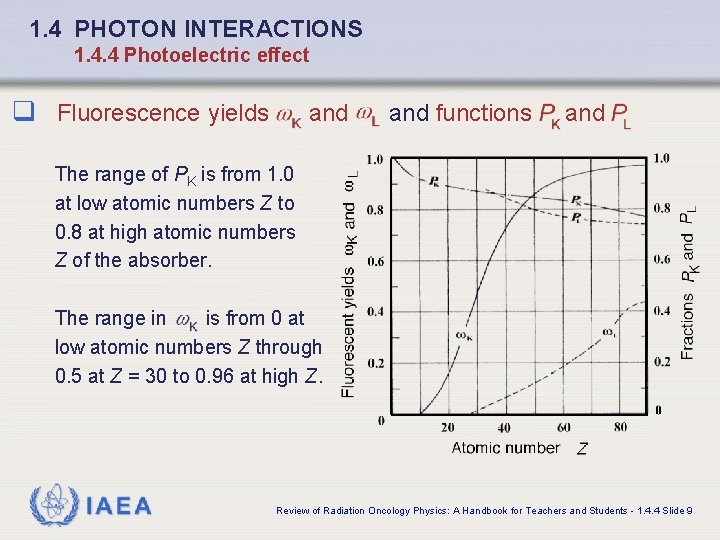
1. 4 PHOTON INTERACTIONS 1. 4. 4 Photoelectric effect q Fluorescence yields and functions and The range of PK is from 1. 0 at low atomic numbers Z to 0. 8 at high atomic numbers Z of the absorber. The range in is from 0 at low atomic numbers Z through 0. 5 at Z = 30 to 0. 96 at high Z. IAEA Review of Radiation Oncology Physics: A Handbook for Teachers and Students - 1. 4. 4 Slide 9
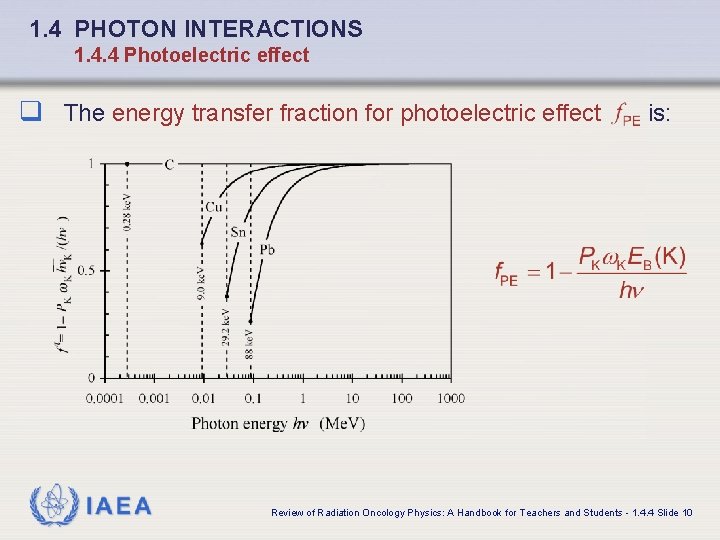
1. 4 PHOTON INTERACTIONS 1. 4. 4 Photoelectric effect q The energy transfer fraction for photoelectric effect IAEA is: Review of Radiation Oncology Physics: A Handbook for Teachers and Students - 1. 4. 4 Slide 10
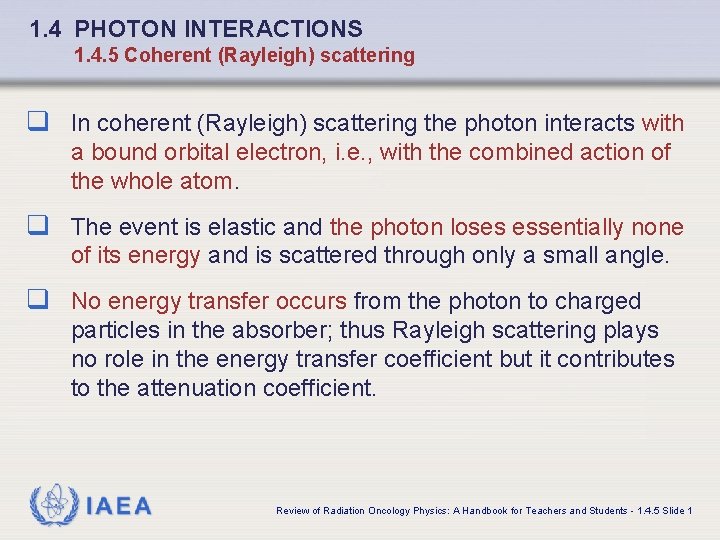
1. 4 PHOTON INTERACTIONS 1. 4. 5 Coherent (Rayleigh) scattering q In coherent (Rayleigh) scattering the photon interacts with a bound orbital electron, i. e. , with the combined action of the whole atom. q The event is elastic and the photon loses essentially none of its energy and is scattered through only a small angle. q No energy transfer occurs from the photon to charged particles in the absorber; thus Rayleigh scattering plays no role in the energy transfer coefficient but it contributes to the attenuation coefficient. IAEA Review of Radiation Oncology Physics: A Handbook for Teachers and Students - 1. 4. 5 Slide 1
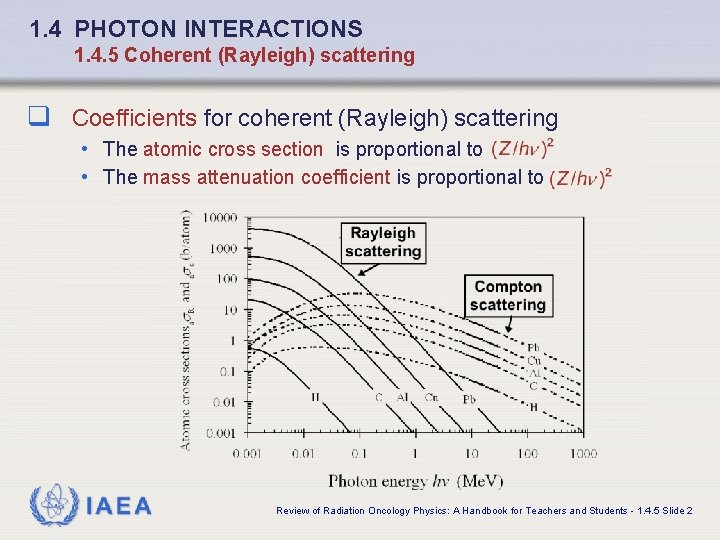
1. 4 PHOTON INTERACTIONS 1. 4. 5 Coherent (Rayleigh) scattering q Coefficients for coherent (Rayleigh) scattering • The atomic cross section is proportional to • The mass attenuation coefficient is proportional to IAEA Review of Radiation Oncology Physics: A Handbook for Teachers and Students - 1. 4. 5 Slide 2
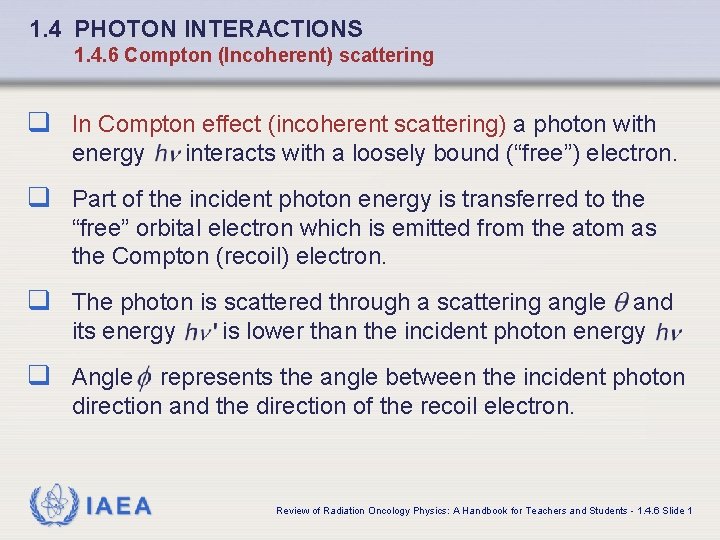
1. 4 PHOTON INTERACTIONS 1. 4. 6 Compton (Incoherent) scattering q In Compton effect (incoherent scattering) a photon with energy interacts with a loosely bound (“free”) electron. q Part of the incident photon energy is transferred to the “free” orbital electron which is emitted from the atom as the Compton (recoil) electron. q The photon is scattered through a scattering angle and its energy is lower than the incident photon energy q Angle represents the angle between the incident photon direction and the direction of the recoil electron. IAEA Review of Radiation Oncology Physics: A Handbook for Teachers and Students - 1. 4. 6 Slide 1
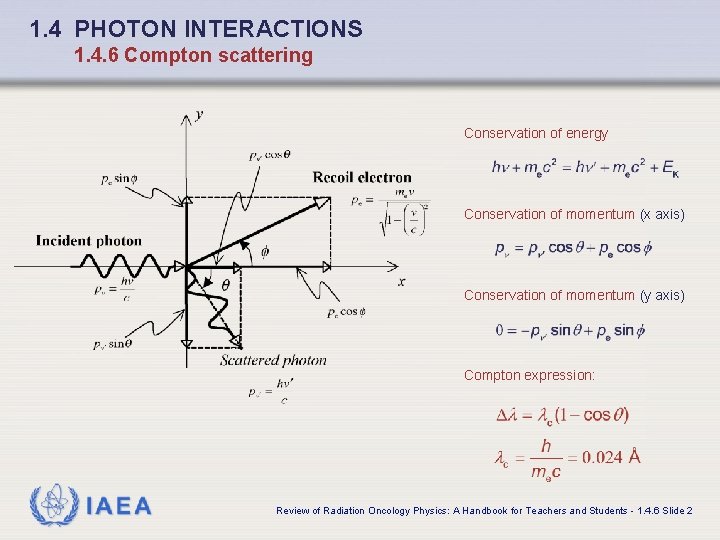
1. 4 PHOTON INTERACTIONS 1. 4. 6 Compton scattering Conservation of energy Conservation of momentum (x axis) Conservation of momentum (y axis) Compton expression: IAEA Review of Radiation Oncology Physics: A Handbook for Teachers and Students - 1. 4. 6 Slide 2
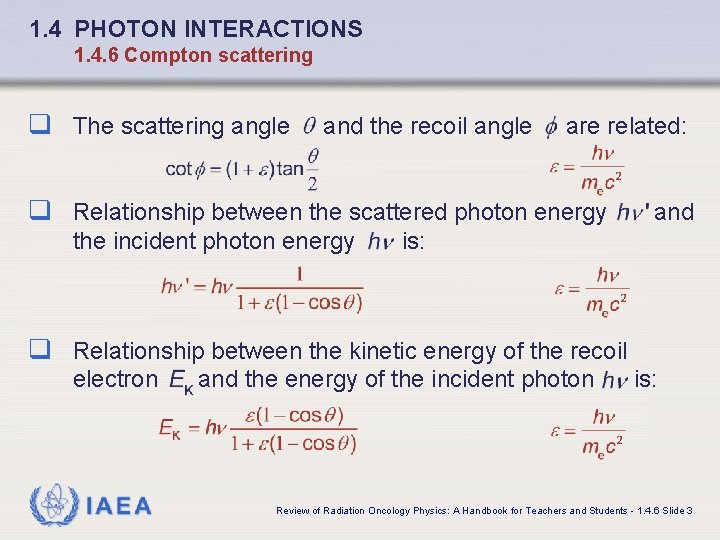
1. 4 PHOTON INTERACTIONS 1. 4. 6 Compton scattering q The scattering angle and the recoil angle are related: q Relationship between the scattered photon energy the incident photon energy and is: q Relationship between the kinetic energy of the recoil electron IAEA and the energy of the incident photon is: Review of Radiation Oncology Physics: A Handbook for Teachers and Students - 1. 4. 6 Slide 3
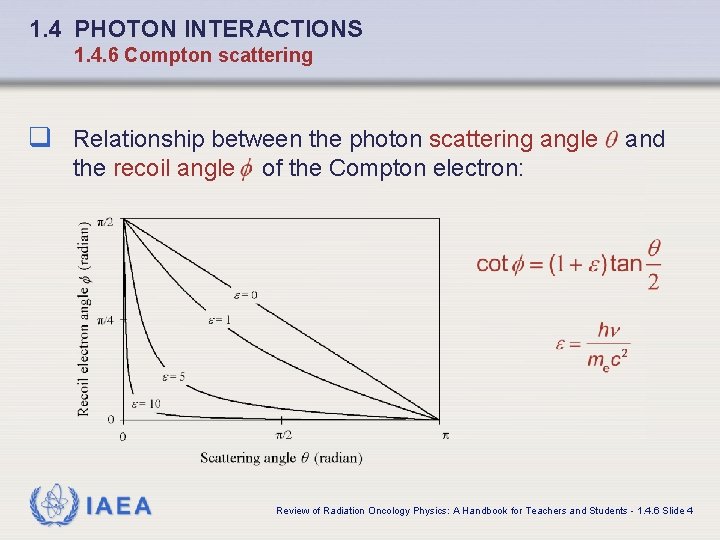
1. 4 PHOTON INTERACTIONS 1. 4. 6 Compton scattering q Relationship between the photon scattering angle and the recoil angle IAEA of the Compton electron: Review of Radiation Oncology Physics: A Handbook for Teachers and Students - 1. 4. 6 Slide 4
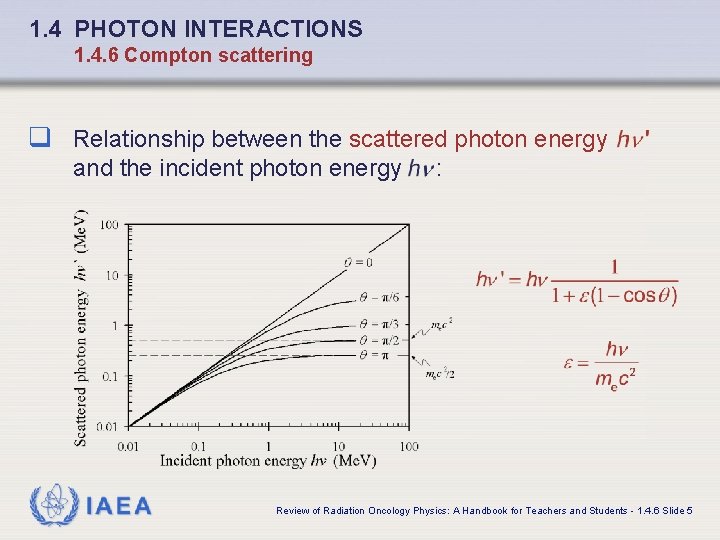
1. 4 PHOTON INTERACTIONS 1. 4. 6 Compton scattering q Relationship between the scattered photon energy and the incident photon energy IAEA : Review of Radiation Oncology Physics: A Handbook for Teachers and Students - 1. 4. 6 Slide 5
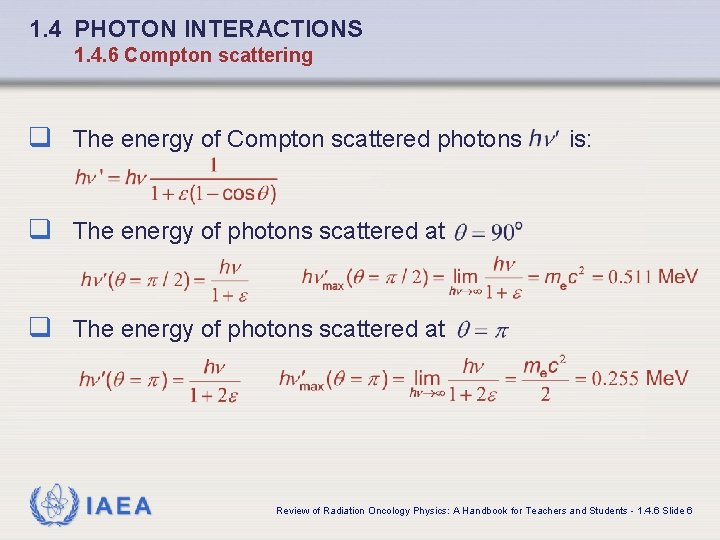
1. 4 PHOTON INTERACTIONS 1. 4. 6 Compton scattering q The energy of Compton scattered photons is: q The energy of photons scattered at IAEA Review of Radiation Oncology Physics: A Handbook for Teachers and Students - 1. 4. 6 Slide 6
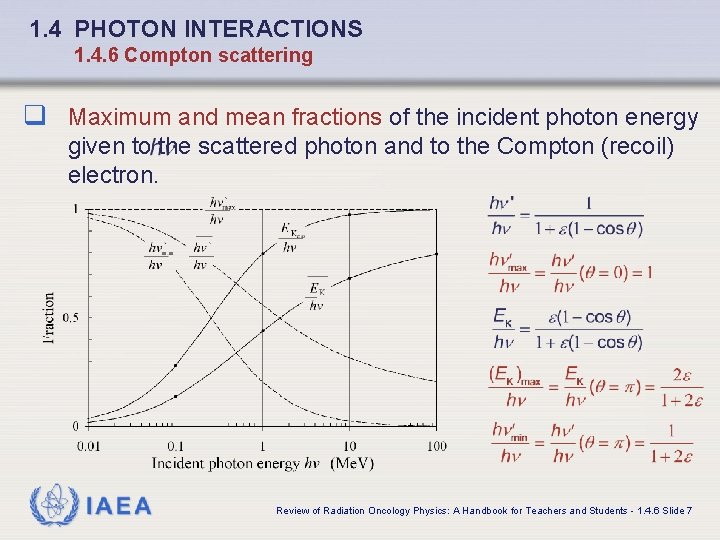
1. 4 PHOTON INTERACTIONS 1. 4. 6 Compton scattering q Maximum and mean fractions of the incident photon energy given to the scattered photon and to the Compton (recoil) electron. IAEA Review of Radiation Oncology Physics: A Handbook for Teachers and Students - 1. 4. 6 Slide 7
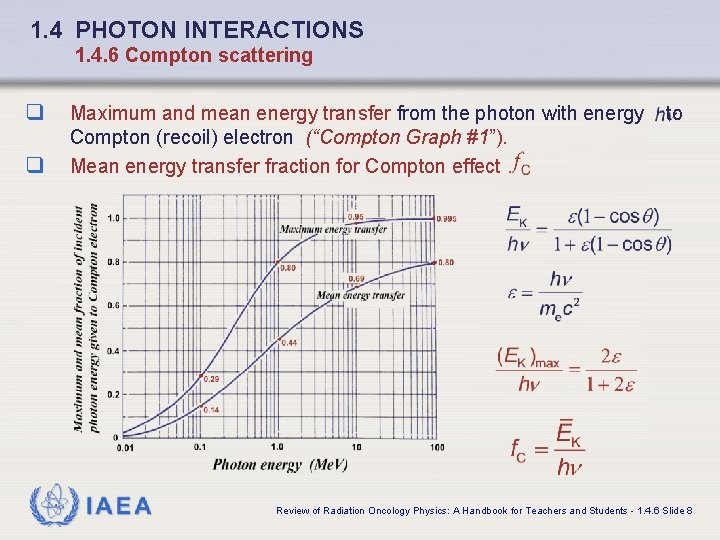
1. 4 PHOTON INTERACTIONS 1. 4. 6 Compton scattering q q Maximum and mean energy transfer from the photon with energy Compton (recoil) electron (“Compton Graph #1”). Mean energy transfer fraction for Compton effect IAEA to Review of Radiation Oncology Physics: A Handbook for Teachers and Students - 1. 4. 6 Slide 8
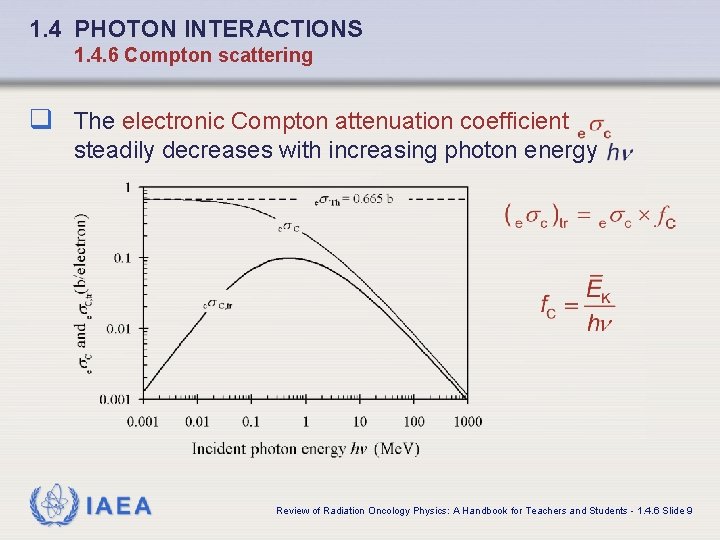
1. 4 PHOTON INTERACTIONS 1. 4. 6 Compton scattering q The electronic Compton attenuation coefficient steadily decreases with increasing photon energy IAEA Review of Radiation Oncology Physics: A Handbook for Teachers and Students - 1. 4. 6 Slide 9
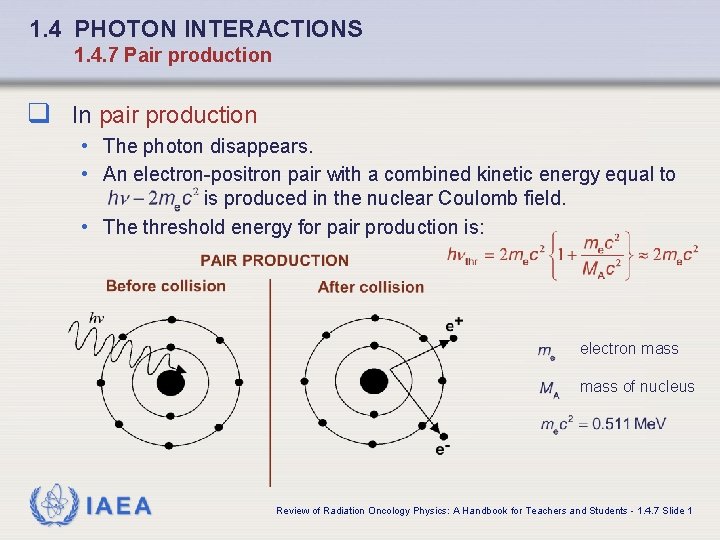
1. 4 PHOTON INTERACTIONS 1. 4. 7 Pair production q In pair production • The photon disappears. • An electron-positron pair with a combined kinetic energy equal to is produced in the nuclear Coulomb field. • The threshold energy for pair production is: electron mass of nucleus IAEA Review of Radiation Oncology Physics: A Handbook for Teachers and Students - 1. 4. 7 Slide 1
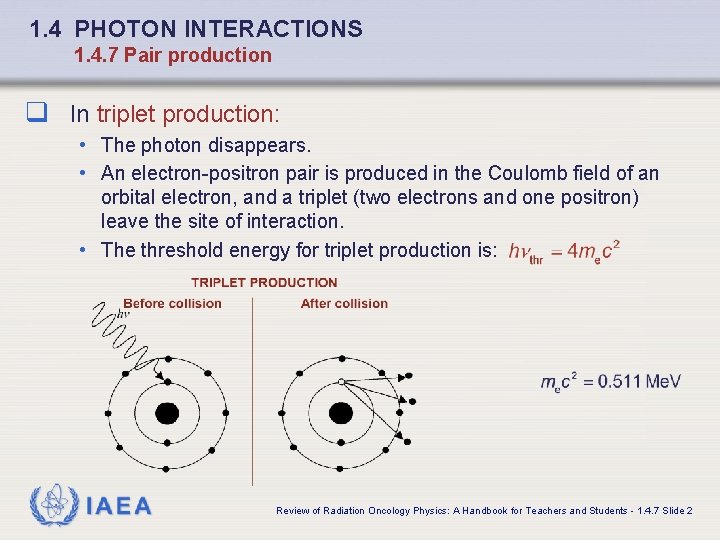
1. 4 PHOTON INTERACTIONS 1. 4. 7 Pair production q In triplet production: • The photon disappears. • An electron-positron pair is produced in the Coulomb field of an orbital electron, and a triplet (two electrons and one positron) leave the site of interaction. • The threshold energy for triplet production is: IAEA Review of Radiation Oncology Physics: A Handbook for Teachers and Students - 1. 4. 7 Slide 2
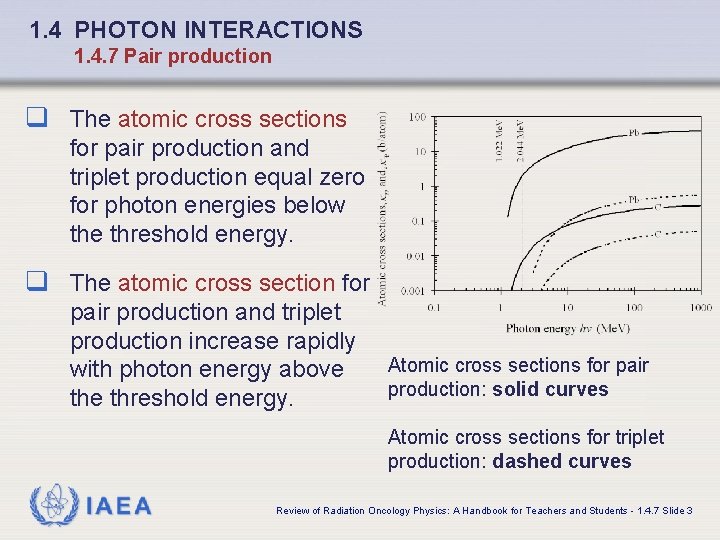
1. 4 PHOTON INTERACTIONS 1. 4. 7 Pair production q The atomic cross sections for pair production and triplet production equal zero for photon energies below the threshold energy. q The atomic cross section for pair production and triplet production increase rapidly with photon energy above threshold energy. Atomic cross sections for pair production: solid curves Atomic cross sections for triplet production: dashed curves IAEA Review of Radiation Oncology Physics: A Handbook for Teachers and Students - 1. 4. 7 Slide 3
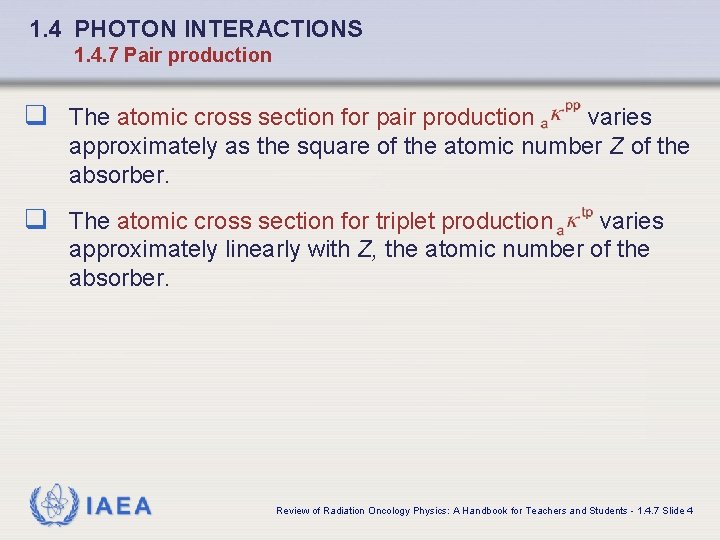
1. 4 PHOTON INTERACTIONS 1. 4. 7 Pair production q The atomic cross section for pair production varies approximately as the square of the atomic number Z of the absorber. q The atomic cross section for triplet production varies approximately linearly with Z, the atomic number of the absorber. IAEA Review of Radiation Oncology Physics: A Handbook for Teachers and Students - 1. 4. 7 Slide 4
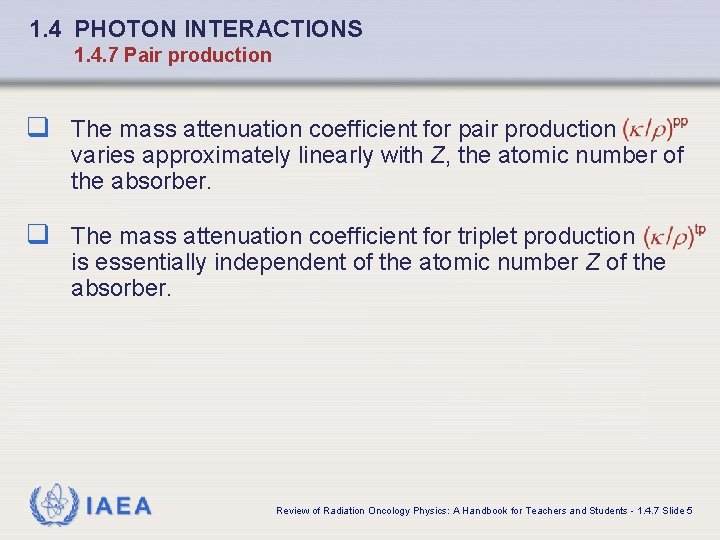
1. 4 PHOTON INTERACTIONS 1. 4. 7 Pair production q The mass attenuation coefficient for pair production varies approximately linearly with Z, the atomic number of the absorber. q The mass attenuation coefficient for triplet production is essentially independent of the atomic number Z of the absorber. IAEA Review of Radiation Oncology Physics: A Handbook for Teachers and Students - 1. 4. 7 Slide 5
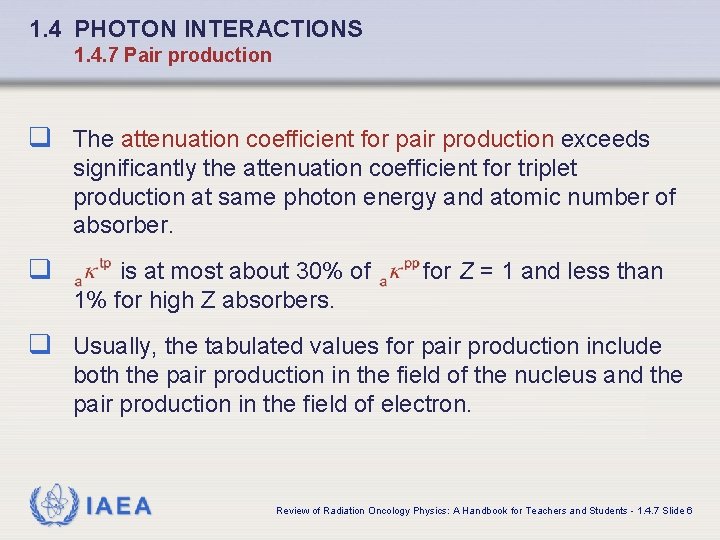
1. 4 PHOTON INTERACTIONS 1. 4. 7 Pair production q The attenuation coefficient for pair production exceeds significantly the attenuation coefficient for triplet production at same photon energy and atomic number of absorber. q is at most about 30% of 1% for high Z absorbers. for Z = 1 and less than q Usually, the tabulated values for pair production include both the pair production in the field of the nucleus and the pair production in the field of electron. IAEA Review of Radiation Oncology Physics: A Handbook for Teachers and Students - 1. 4. 7 Slide 6
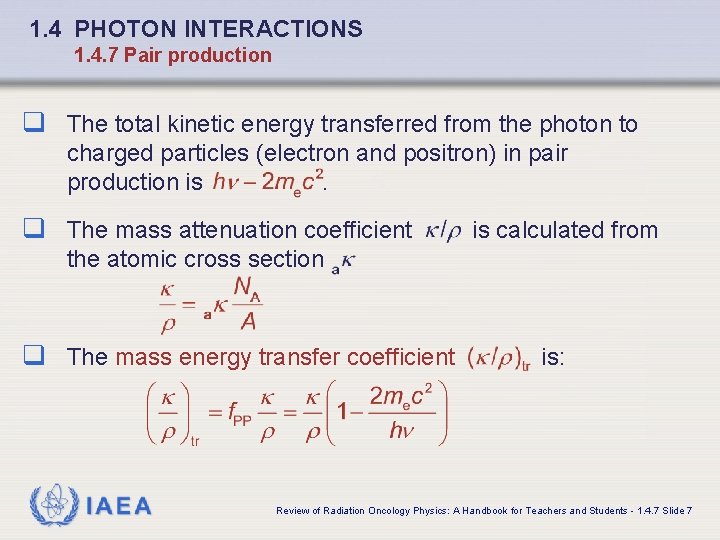
1. 4 PHOTON INTERACTIONS 1. 4. 7 Pair production q The total kinetic energy transferred from the photon to charged particles (electron and positron) in pair production is. q The mass attenuation coefficient is calculated from the atomic cross section q The mass energy transfer coefficient IAEA is: Review of Radiation Oncology Physics: A Handbook for Teachers and Students - 1. 4. 7 Slide 7
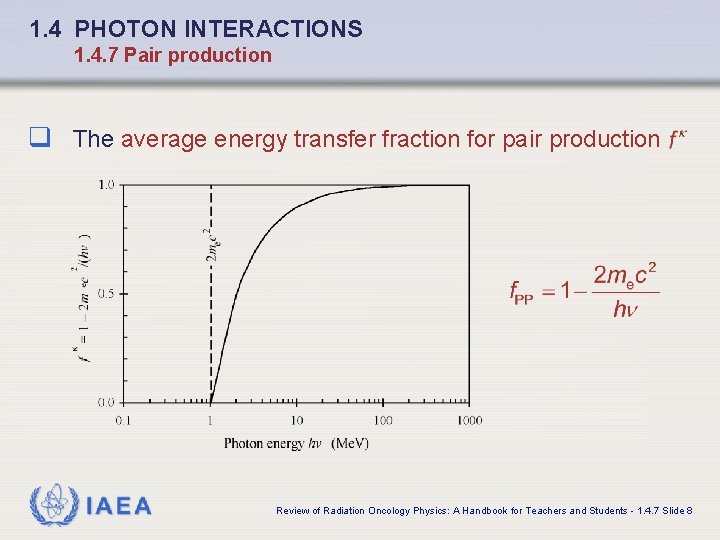
1. 4 PHOTON INTERACTIONS 1. 4. 7 Pair production q The average energy transfer fraction for pair production IAEA Review of Radiation Oncology Physics: A Handbook for Teachers and Students - 1. 4. 7 Slide 8
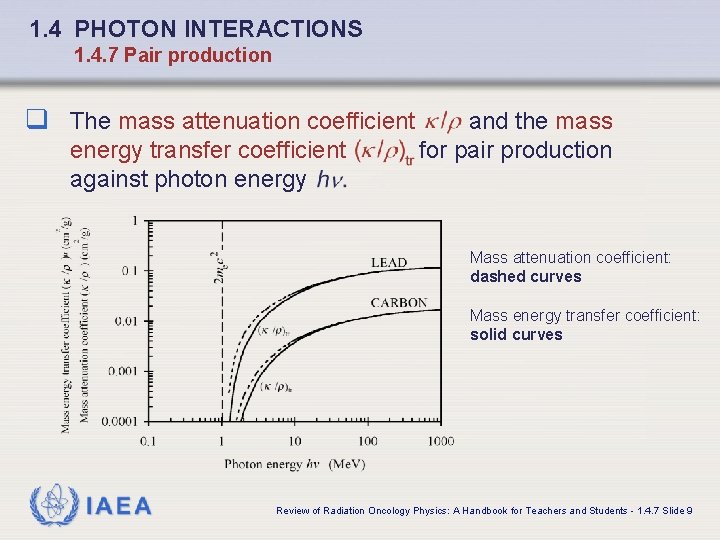
1. 4 PHOTON INTERACTIONS 1. 4. 7 Pair production q The mass attenuation coefficient energy transfer coefficient against photon energy and the mass for pair production Mass attenuation coefficient: dashed curves Mass energy transfer coefficient: solid curves IAEA Review of Radiation Oncology Physics: A Handbook for Teachers and Students - 1. 4. 7 Slide 9
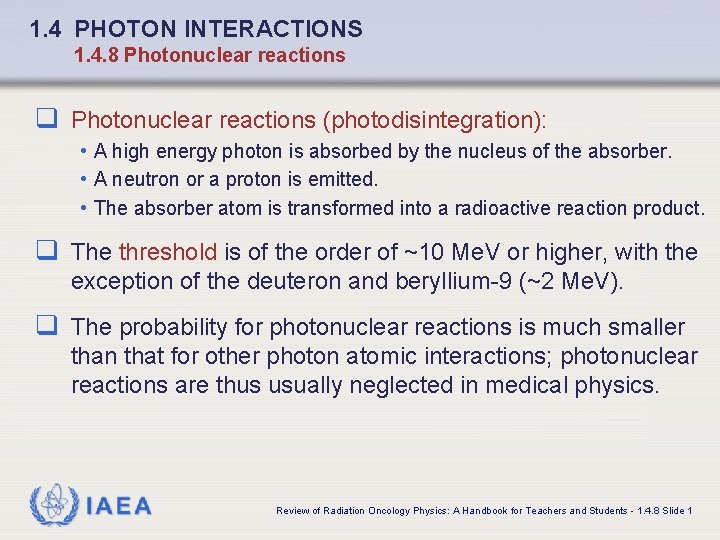
1. 4 PHOTON INTERACTIONS 1. 4. 8 Photonuclear reactions q Photonuclear reactions (photodisintegration): • A high energy photon is absorbed by the nucleus of the absorber. • A neutron or a proton is emitted. • The absorber atom is transformed into a radioactive reaction product. q The threshold is of the order of ~10 Me. V or higher, with the exception of the deuteron and beryllium-9 (~2 Me. V). q The probability for photonuclear reactions is much smaller than that for other photon atomic interactions; photonuclear reactions are thus usually neglected in medical physics. IAEA Review of Radiation Oncology Physics: A Handbook for Teachers and Students - 1. 4. 8 Slide 1
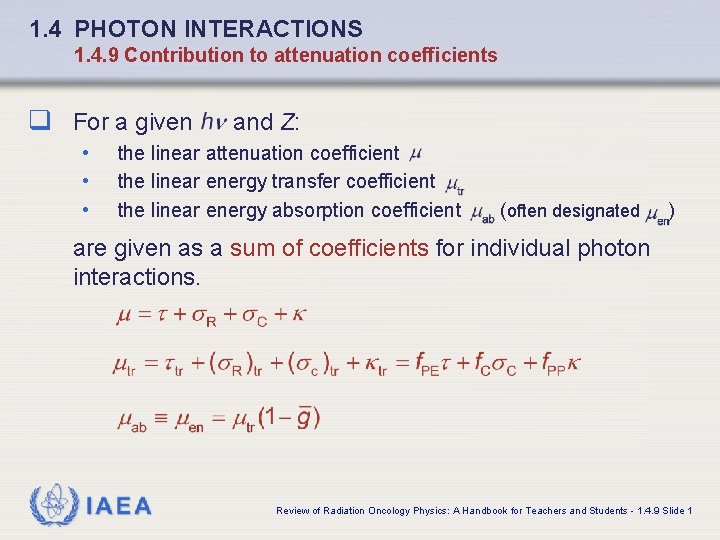
1. 4 PHOTON INTERACTIONS 1. 4. 9 Contribution to attenuation coefficients q For a given • • • and Z: the linear attenuation coefficient the linear energy transfer coefficient the linear energy absorption coefficient (often designated ) are given as a sum of coefficients for individual photon interactions. IAEA Review of Radiation Oncology Physics: A Handbook for Teachers and Students - 1. 4. 9 Slide 1
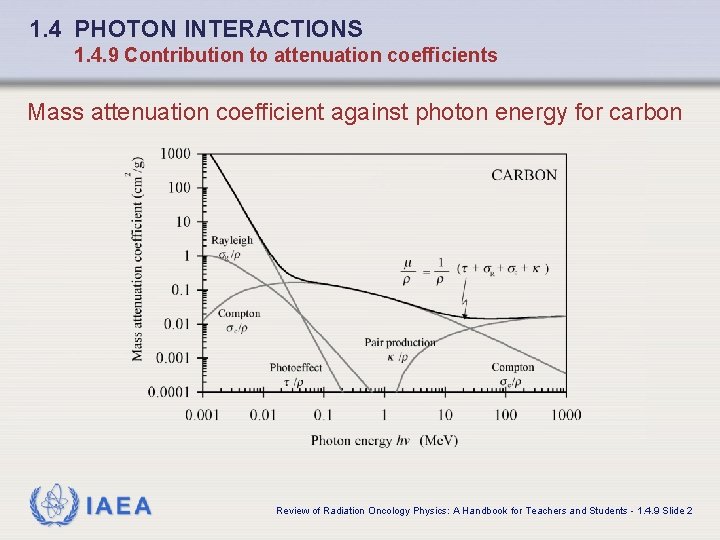
1. 4 PHOTON INTERACTIONS 1. 4. 9 Contribution to attenuation coefficients Mass attenuation coefficient against photon energy for carbon IAEA Review of Radiation Oncology Physics: A Handbook for Teachers and Students - 1. 4. 9 Slide 2
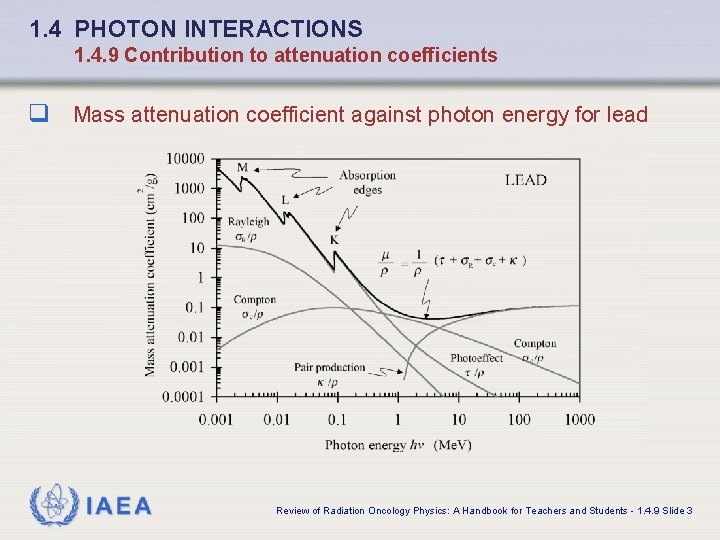
1. 4 PHOTON INTERACTIONS 1. 4. 9 Contribution to attenuation coefficients q Mass attenuation coefficient against photon energy for lead IAEA Review of Radiation Oncology Physics: A Handbook for Teachers and Students - 1. 4. 9 Slide 3
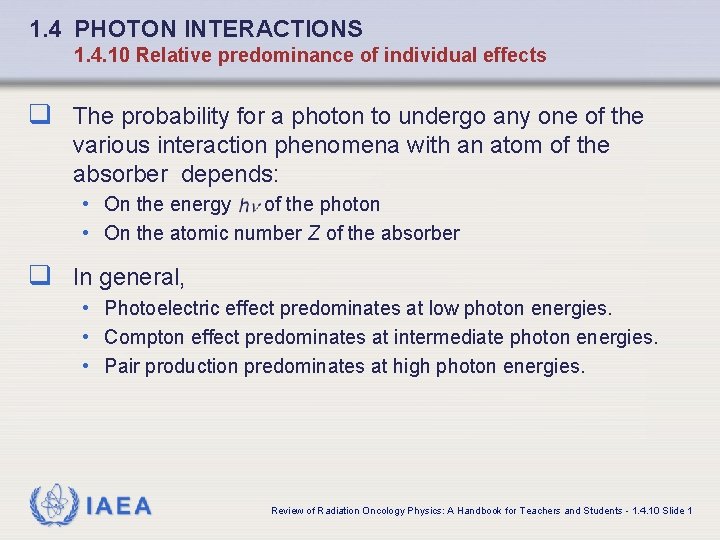
1. 4 PHOTON INTERACTIONS 1. 4. 10 Relative predominance of individual effects q The probability for a photon to undergo any one of the various interaction phenomena with an atom of the absorber depends: • On the energy of the photon • On the atomic number Z of the absorber q In general, • Photoelectric effect predominates at low photon energies. • Compton effect predominates at intermediate photon energies. • Pair production predominates at high photon energies. IAEA Review of Radiation Oncology Physics: A Handbook for Teachers and Students - 1. 4. 10 Slide 1
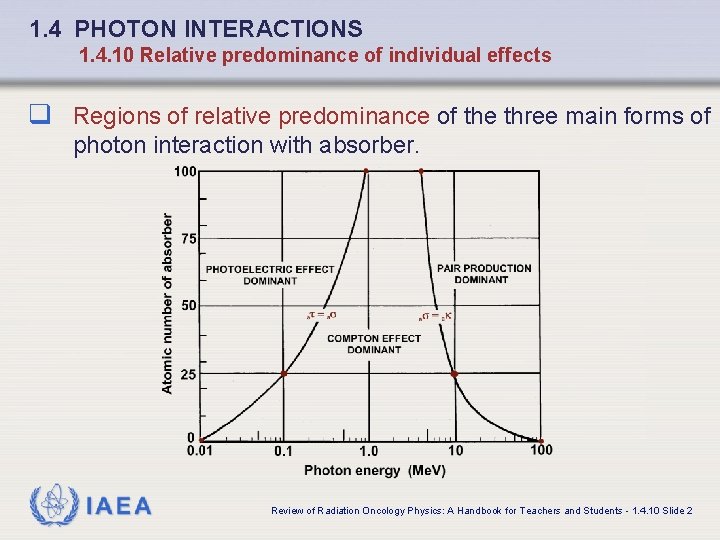
1. 4 PHOTON INTERACTIONS 1. 4. 10 Relative predominance of individual effects q Regions of relative predominance of the three main forms of photon interaction with absorber. IAEA Review of Radiation Oncology Physics: A Handbook for Teachers and Students - 1. 4. 10 Slide 2
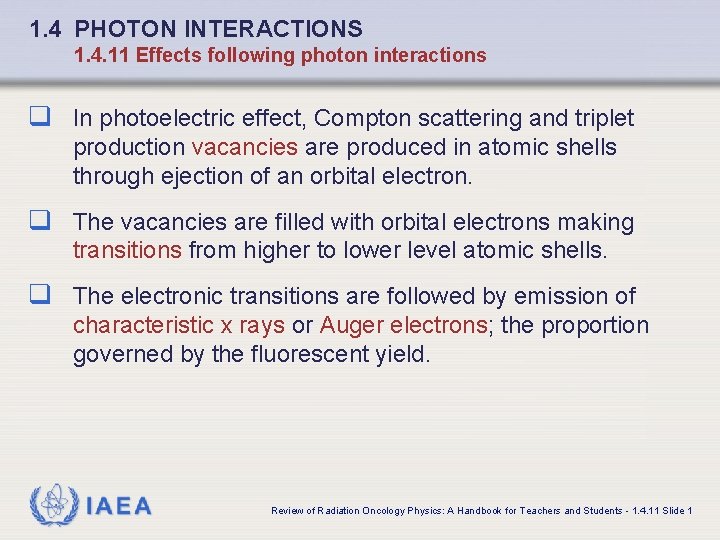
1. 4 PHOTON INTERACTIONS 1. 4. 11 Effects following photon interactions q In photoelectric effect, Compton scattering and triplet production vacancies are produced in atomic shells through ejection of an orbital electron. q The vacancies are filled with orbital electrons making transitions from higher to lower level atomic shells. q The electronic transitions are followed by emission of characteristic x rays or Auger electrons; the proportion governed by the fluorescent yield. IAEA Review of Radiation Oncology Physics: A Handbook for Teachers and Students - 1. 4. 11 Slide 1
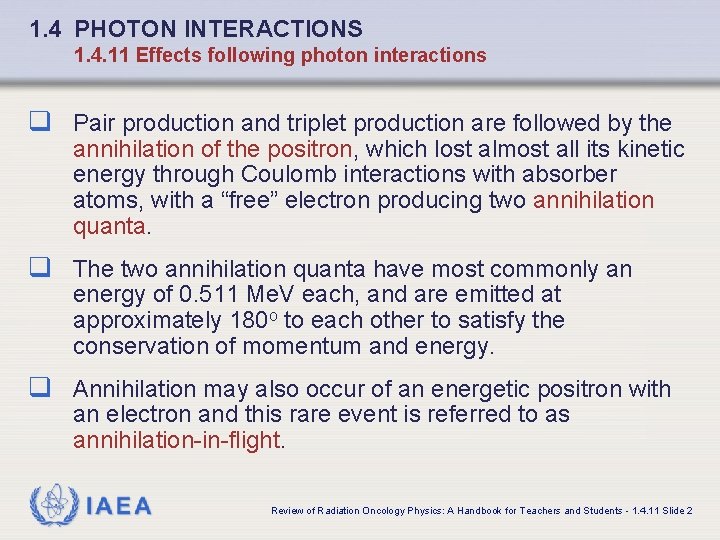
1. 4 PHOTON INTERACTIONS 1. 4. 11 Effects following photon interactions q Pair production and triplet production are followed by the annihilation of the positron, which lost almost all its kinetic energy through Coulomb interactions with absorber atoms, with a “free” electron producing two annihilation quanta. q The two annihilation quanta have most commonly an energy of 0. 511 Me. V each, and are emitted at approximately 180 o to each other to satisfy the conservation of momentum and energy. q Annihilation may also occur of an energetic positron with an electron and this rare event is referred to as annihilation-in-flight. IAEA Review of Radiation Oncology Physics: A Handbook for Teachers and Students - 1. 4. 11 Slide 2
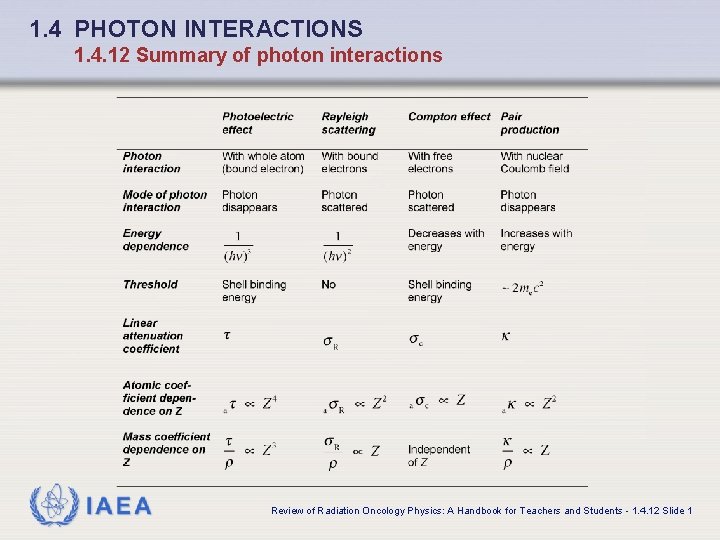
1. 4 PHOTON INTERACTIONS 1. 4. 12 Summary of photon interactions IAEA Review of Radiation Oncology Physics: A Handbook for Teachers and Students - 1. 4. 12 Slide 1
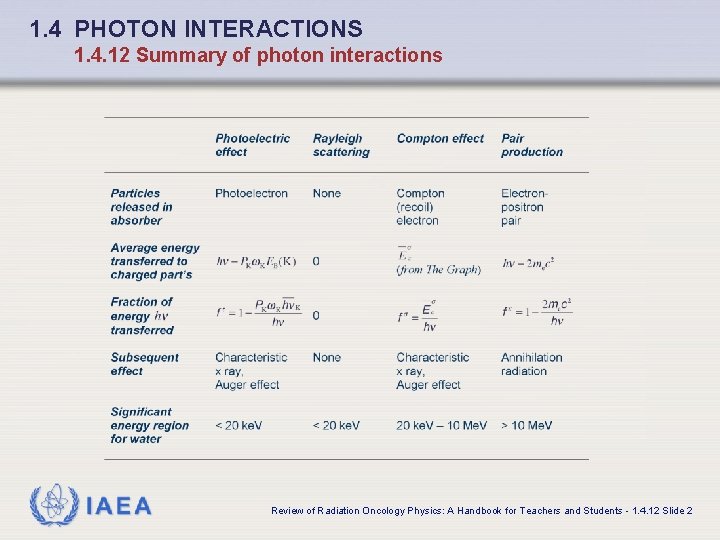
1. 4 PHOTON INTERACTIONS 1. 4. 12 Summary of photon interactions IAEA Review of Radiation Oncology Physics: A Handbook for Teachers and Students - 1. 4. 12 Slide 2
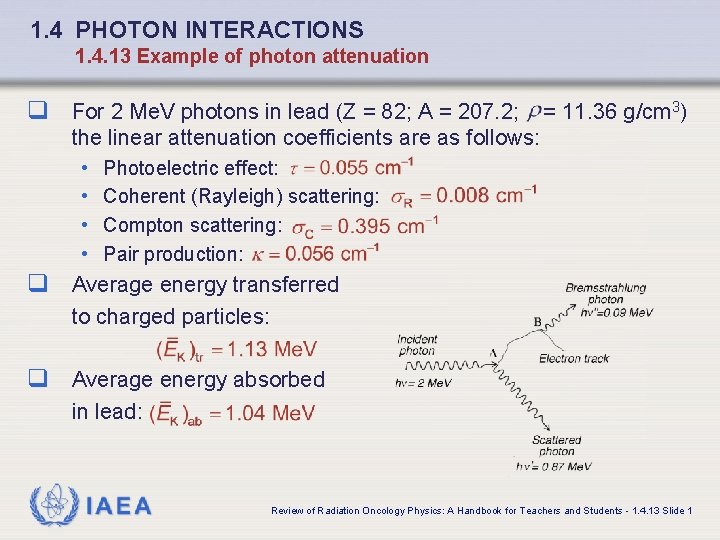
1. 4 PHOTON INTERACTIONS 1. 4. 13 Example of photon attenuation q For 2 Me. V photons in lead (Z = 82; A = 207. 2; = 11. 36 g/cm 3) q the linear attenuation coefficients are as follows: • Photoelectric effect: • Coherent (Rayleigh) scattering: • Compton scattering: • Pair production: Average energy transferred to charged particles: q Average energy absorbed in lead: IAEA Review of Radiation Oncology Physics: A Handbook for Teachers and Students - 1. 4. 13 Slide 1
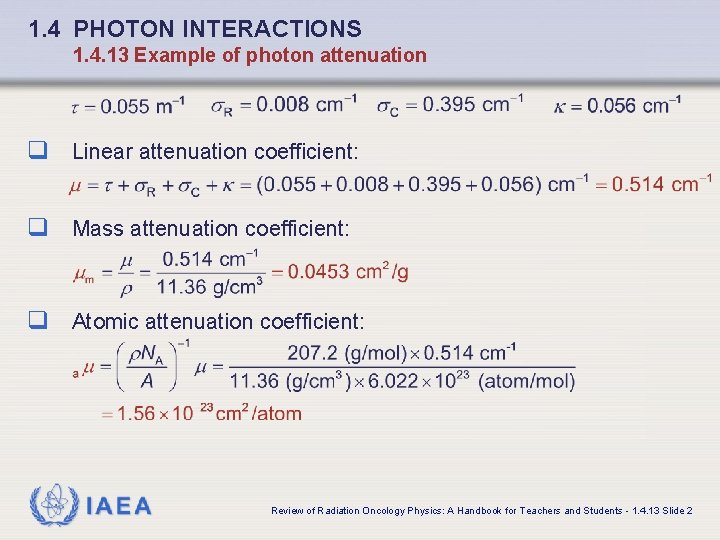
1. 4 PHOTON INTERACTIONS 1. 4. 13 Example of photon attenuation q Linear attenuation coefficient: q Mass attenuation coefficient: q Atomic attenuation coefficient: IAEA Review of Radiation Oncology Physics: A Handbook for Teachers and Students - 1. 4. 13 Slide 2
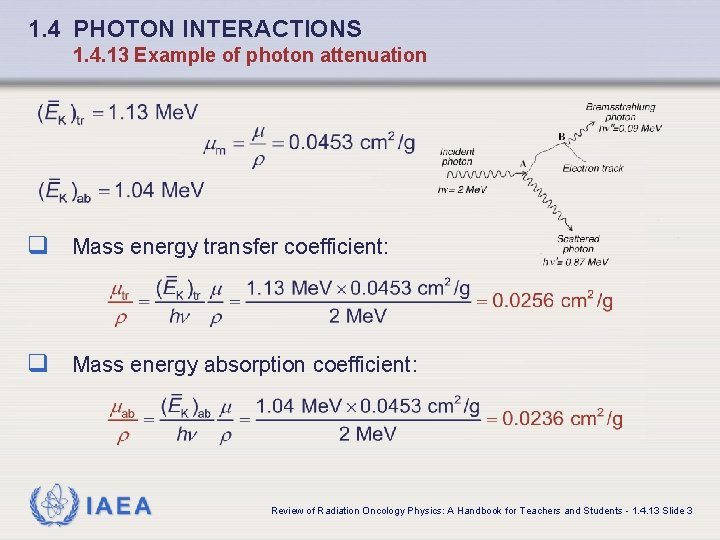
1. 4 PHOTON INTERACTIONS 1. 4. 13 Example of photon attenuation q Mass energy transfer coefficient: q Mass energy absorption coefficient: IAEA Review of Radiation Oncology Physics: A Handbook for Teachers and Students - 1. 4. 13 Slide 3
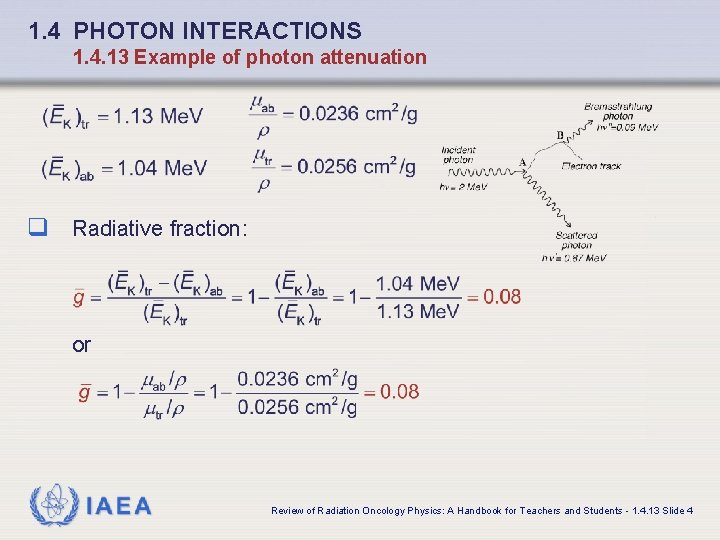
1. 4 PHOTON INTERACTIONS 1. 4. 13 Example of photon attenuation q Radiative fraction: or IAEA Review of Radiation Oncology Physics: A Handbook for Teachers and Students - 1. 4. 13 Slide 4
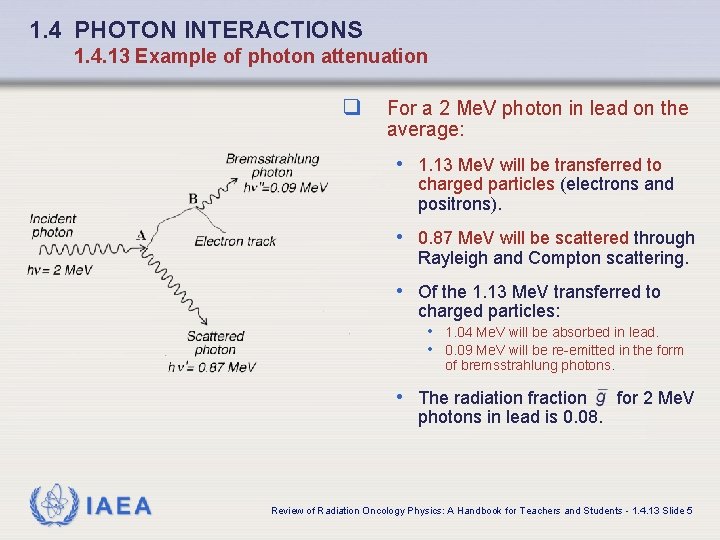
1. 4 PHOTON INTERACTIONS 1. 4. 13 Example of photon attenuation q For a 2 Me. V photon in lead on the average: • 1. 13 Me. V will be transferred to charged particles (electrons and positrons). • 0. 87 Me. V will be scattered through Rayleigh and Compton scattering. • Of the 1. 13 Me. V transferred to charged particles: • 1. 04 Me. V will be absorbed in lead. • 0. 09 Me. V will be re-emitted in the form of bremsstrahlung photons. • The radiation fraction photons in lead is 0. 08. IAEA for 2 Me. V Review of Radiation Oncology Physics: A Handbook for Teachers and Students - 1. 4. 13 Slide 5
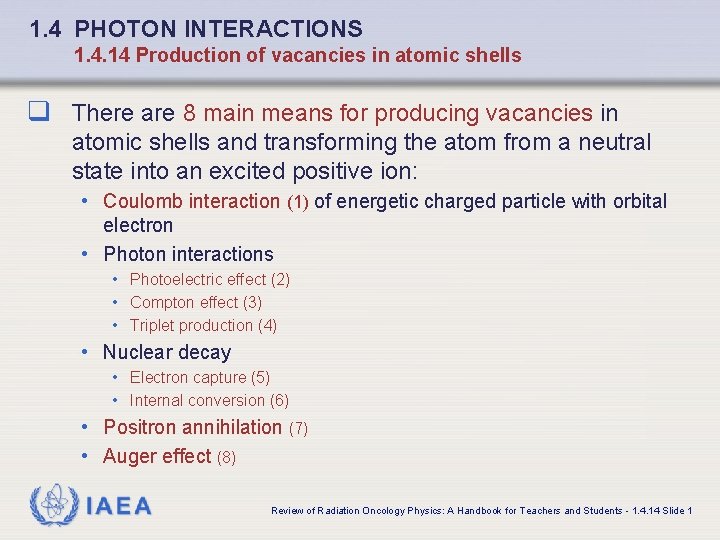
1. 4 PHOTON INTERACTIONS 1. 4. 14 Production of vacancies in atomic shells q There are 8 main means for producing vacancies in atomic shells and transforming the atom from a neutral state into an excited positive ion: • Coulomb interaction (1) of energetic charged particle with orbital electron • Photon interactions • Photoelectric effect (2) • Compton effect (3) • Triplet production (4) • Nuclear decay • Electron capture (5) • Internal conversion (6) • Positron annihilation (7) • Auger effect (8) IAEA Review of Radiation Oncology Physics: A Handbook for Teachers and Students - 1. 4. 14 Slide 1
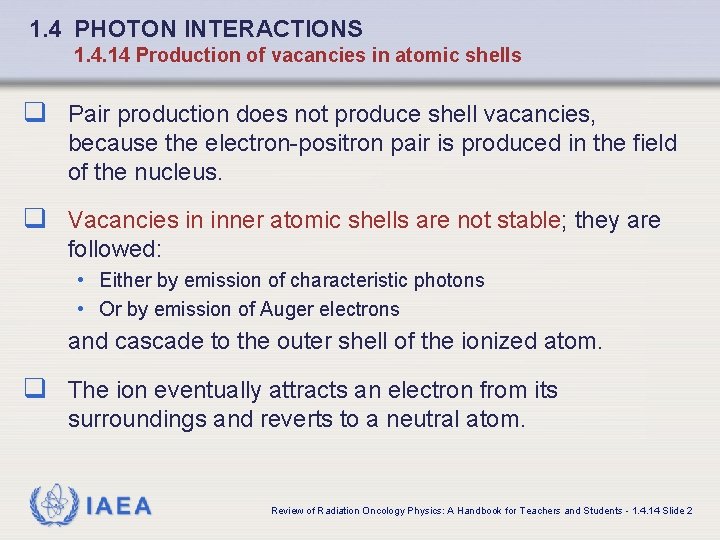
1. 4 PHOTON INTERACTIONS 1. 4. 14 Production of vacancies in atomic shells q Pair production does not produce shell vacancies, because the electron-positron pair is produced in the field of the nucleus. q Vacancies in inner atomic shells are not stable; they are followed: • Either by emission of characteristic photons • Or by emission of Auger electrons and cascade to the outer shell of the ionized atom. q The ion eventually attracts an electron from its surroundings and reverts to a neutral atom. IAEA Review of Radiation Oncology Physics: A Handbook for Teachers and Students - 1. 4. 14 Slide 2
- Slides: 194